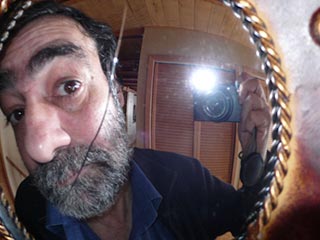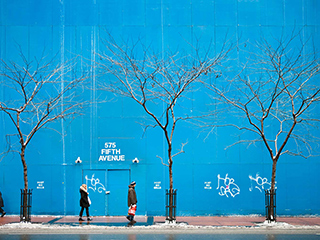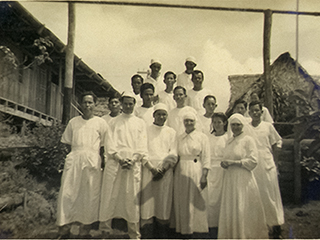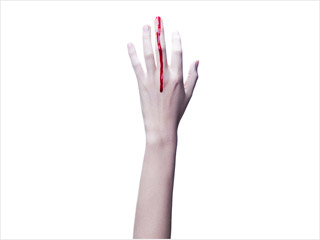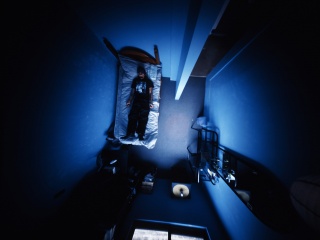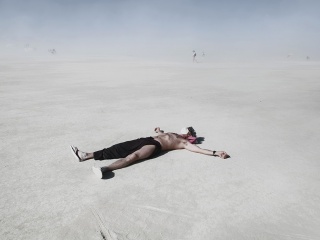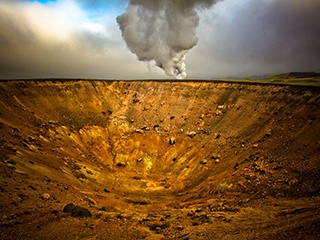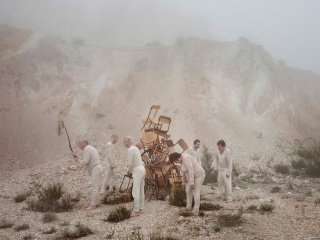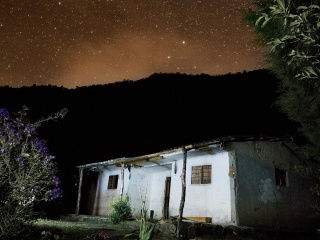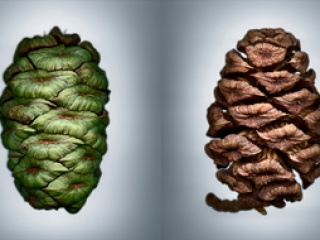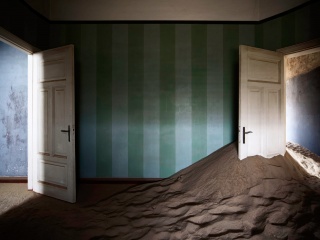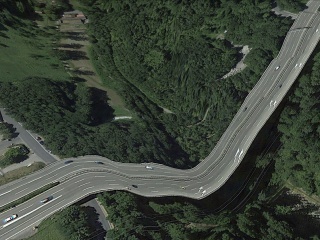Trish Morrissey
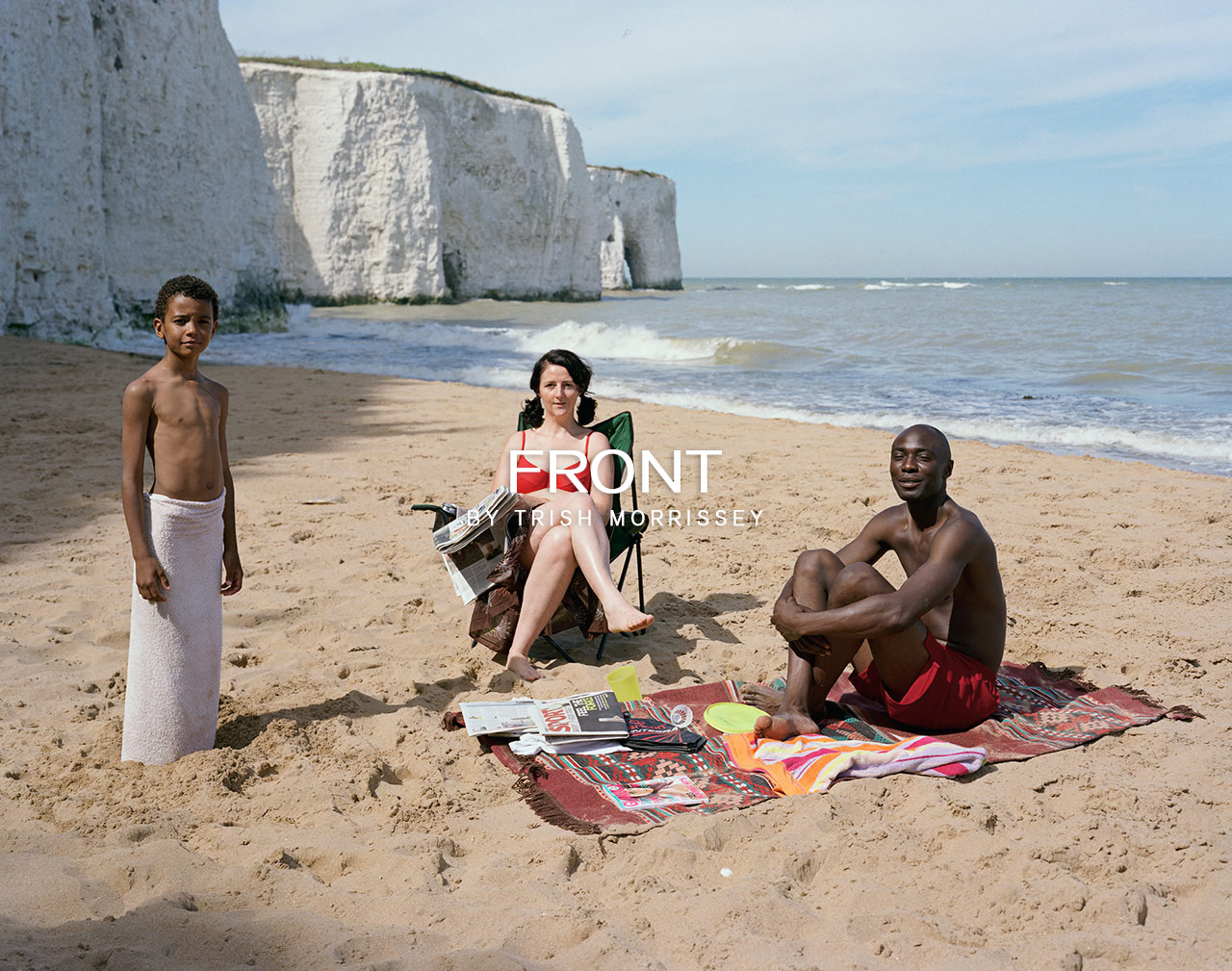
Front (2005-2007) deals with the notion of borders, boundaries and the edge, using the family group and the beach setting as metaphors. For this work, the artist travelled to beaches in the UK and around Melbourne. She approached families and groups of friends who had made temporary encampments, or marked out territories and asked if she could be part of their family temporarily. Morrissey then took over the role or position of a woman within that group - usually the mother figure. She asked to take her place, and to borrow her clothes. The woman then took over the artist's role and photographed her family using a 4x5 camera (which Morrissey had already carefully set up). While Morrissey, a stranger on the beach, nestled in with her loved ones. These highly performative photographs are shaped by chance encounters with strangers, and by what happens when physical and psychological boundaries are crossed. Ideas around the mythological creature the 'shape shifter' and the cuckoo are evoked. Each piece within the series is titled by the name of the woman who Morrissey replaced within the group.












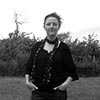 Trish Morrissey (Ireland, 1967). Lives and works in Dublin. She received a master´s degree in Photography from the University for Arts, London (2000-2001). She works with photography, film and video. She has participated in exhibitions around the world, including solo shows at Impressions Gallery, Bradford, UK; Pumphouse Gallery, London, UK; Yossi Milo Gallery, New York, USA; Gallery of Photography, Dublin, Ireland; and the Centre for Contemporary Photography, Melbourne, Australia. To see more of her work go to: trishmorrissey.
Trish Morrissey (Ireland, 1967). Lives and works in Dublin. She received a master´s degree in Photography from the University for Arts, London (2000-2001). She works with photography, film and video. She has participated in exhibitions around the world, including solo shows at Impressions Gallery, Bradford, UK; Pumphouse Gallery, London, UK; Yossi Milo Gallery, New York, USA; Gallery of Photography, Dublin, Ireland; and the Centre for Contemporary Photography, Melbourne, Australia. To see more of her work go to: trishmorrissey.ZZ. In the project Front you assume very diverse roles. How was it to adopt these different roles and to integrate yourself in such a way as to go unnoticed?
TM. The work was made over a 2 year period in which I became pregnant and had my first child, so my body shape was in constant flux. The period where I was obviously pregnant was over the winter, so no beach shots could be done, but I gained and lost 20kg (really!) which meant that my face changed a lot as well as my body. I think this helps the viewer assume they are seeing a different person in each picture on first viewing. It usually takes a while for them to realise it is the same person in each image. I also think that the language of photography is very familiar to everyone, even on a subconscious level. So when presented with a picture of 'a family' we have no reason to think that the photograph is anything else. People even see 'family resemblance' in these photographs where there is none. I also realised fairly early on in the process that in order to get people to receive my request to be part of an art project about families positively, I needed to already look like I was part of their tribe before I even approached them. If I didn't, then they usually rejected my request. So on my beach trips, I always carried a large bag of clothes. I would scout the beach quietly and pick a family who I wanted to work with, then change my clothes so that I would fit in before I approached them.
ZZ. Which aspects of your own identity do you find in each representation that you do of another person?
TM. I think it is no coincidence that I was newly pregnant when I started this project. In some ways, subconsiously I was 'trying on' motherhood, or in the pictures of groups of friends, I was imagining how life might carry on if I did not become a mother.
ZZ. Do you seek to provoke something in particular when you take people out of their context and replace them? How did people react to seeing themselves being replaced by you and to observe their lives from a distance, without them being present?
TM. I am using the beach as a metaphor for borders, boundaries and edges. The family unit has both physical and psychological boundaries, the beach is the border between culture and order (the land) and nature and chaos (the sea). By asking to be photographed with the family, and for the mother to come out of the picture and become the photographer, I am disrupting this boundary. It was a very strange feeling for the woman to do this, and I think because I was asking people who were more or less my own age and because I am a woman (I don't think a man would have the same success asking to be the father figure in the picture, and asking the man to step away from his family) and we had a rapport, the pictures were possible. One woman said 'Oh my God, it is as if I have died and my husband has a new wife!)

Front (2005-2007) deals with the notion of borders, boundaries and the edge, using the family group and the beach setting as metaphors. For this work, the artist travelled to beaches in the UK and around Melbourne. She approached families and groups of friends who had made temporary encampments, or marked out territories and asked if she could be part of their family temporarily. Morrissey then took over the role or position of a woman within that group - usually the mother figure. She asked to take her place, and to borrow her clothes. The woman then took over the artist's role and photographed her family using a 4x5 camera (which Morrissey had already carefully set up). While Morrissey, a stranger on the beach, nestled in with her loved ones. These highly performative photographs are shaped by chance encounters with strangers, and by what happens when physical and psychological boundaries are crossed. Ideas around the mythological creature the 'shape shifter' and the cuckoo are evoked. Each piece within the series is titled by the name of the woman who Morrissey replaced within the group.












 Trish Morrissey (Ireland, 1967). Lives and works in Dublin. She received a master´s degree in Photography from the University for Arts, London (2000-2001). She works with photography, film and video. She has participated in exhibitions around the world, including solo shows at Impressions Gallery, Bradford, UK; Pumphouse Gallery, London, UK; Yossi Milo Gallery, New York, USA; Gallery of Photography, Dublin, Ireland; and the Centre for Contemporary Photography, Melbourne, Australia. To see more of her work go to: trishmorrissey.
Trish Morrissey (Ireland, 1967). Lives and works in Dublin. She received a master´s degree in Photography from the University for Arts, London (2000-2001). She works with photography, film and video. She has participated in exhibitions around the world, including solo shows at Impressions Gallery, Bradford, UK; Pumphouse Gallery, London, UK; Yossi Milo Gallery, New York, USA; Gallery of Photography, Dublin, Ireland; and the Centre for Contemporary Photography, Melbourne, Australia. To see more of her work go to: trishmorrissey.ZZ. In the project Front you assume very diverse roles. How was it to adopt these different roles and to integrate yourself in such a way as to go unnoticed?
TM. The work was made over a 2 year period in which I became pregnant and had my first child, so my body shape was in constant flux. The period where I was obviously pregnant was over the winter, so no beach shots could be done, but I gained and lost 20kg (really!) which meant that my face changed a lot as well as my body. I think this helps the viewer assume they are seeing a different person in each picture on first viewing. It usually takes a while for them to realise it is the same person in each image. I also think that the language of photography is very familiar to everyone, even on a subconscious level. So when presented with a picture of 'a family' we have no reason to think that the photograph is anything else. People even see 'family resemblance' in these photographs where there is none. I also realised fairly early on in the process that in order to get people to receive my request to be part of an art project about families positively, I needed to already look like I was part of their tribe before I even approached them. If I didn't, then they usually rejected my request. So on my beach trips, I always carried a large bag of clothes. I would scout the beach quietly and pick a family who I wanted to work with, then change my clothes so that I would fit in before I approached them.
ZZ. Which aspects of your own identity do you find in each representation that you do of another person?
TM. I think it is no coincidence that I was newly pregnant when I started this project. In some ways, subconsiously I was 'trying on' motherhood, or in the pictures of groups of friends, I was imagining how life might carry on if I did not become a mother.
ZZ. Do you seek to provoke something in particular when you take people out of their context and replace them? How did people react to seeing themselves being replaced by you and to observe their lives from a distance, without them being present?
TM. I am using the beach as a metaphor for borders, boundaries and edges. The family unit has both physical and psychological boundaries, the beach is the border between culture and order (the land) and nature and chaos (the sea). By asking to be photographed with the family, and for the mother to come out of the picture and become the photographer, I am disrupting this boundary. It was a very strange feeling for the woman to do this, and I think because I was asking people who were more or less my own age and because I am a woman (I don't think a man would have the same success asking to be the father figure in the picture, and asking the man to step away from his family) and we had a rapport, the pictures were possible. One woman said 'Oh my God, it is as if I have died and my husband has a new wife!)
Vanessa Alcaíno & Elisa Rugo
That which I call my self-portrait is composed of thousands of days of work.
Each of them corresponds to the exact number and moment at which
I stopped as I painted after a task.
—Roman Opalka
Through the various forms of artistic expression over the last 500 years, the natural relationship born between the creator and his work tool has offered a rough testimony of self-exploration. We can see it from the self-portraits of Renaissance painters to the self-explorations produced by photographers opposite a mirror. The difference is that today we live in, thorough and for the image, and the image has driven us to communicate in a new way. Today, it has become a right to possess images of one’s self, and in this context the selfie appears to have emerged as a logical derivation of this human action.
Could we therefore consider selfies within the tradition of the self-portrait? Do they serve to search for, or develop, one’s identity? Let us begin with the idea that a selfie is not only a self-portrait in the traditional sense of the word. The selfie is created using a smart phone or webcam and places us in a spontaneous context or situation, showing its relative lack of preparation, but it also contains metadata that are commented on and shared repeatedly. This could define it as an emerging sub-genre of the self-portrait1, as taking this photographic image is in line with the new platforms of audiovisual communication.
However, the most appealing facet of this “new” trend is its social value. Current-day self-portraits do not seek to say this is me or this is how I am, as was done in times gone by to construct an identity, but rather they follow the logic of here I am or this is where I am. Being somewhere at a given moment prevails over just being. Persons therefore show themselves in a location, saying: this is where and how I am right now, with a mood: this is how I am today, or even, when in company: here I am with so-and-so. “Photography is not a memory, but an act”.2
The numerous self-portraits published every day construct visual diaries that show us multiple, plural and at the same time communal “private” stories. They are, in the digital era, the result of the democratization of the image, and acquire meaning once they are shared, not only among a specific group of persons (friends and/or relatives), but among all those who construct meaning through their interactions. The more active the exchange in networks, the stronger the links between their participants.
There are currently pages specializing in selfies that gather images in similar situations (selfiesatfunerals, selfieswithhomelesspeople, selfiesatseriousplaces, museumselfies.tumblr.com), projects that bring together collections of the (app.thefacesoffacebook, A través del espejo by Joan Fontcuberta), studies (selfiecity.net), new trends (Shaky Selfie), competitions, festivals (ClaroEcuador, Olimpiadas del selfie) and every day new apps appear that encourage us to tell a story by capturing images (Frontback). On many occasions film stars, musicians and celebrities such as the Pope or presidents express themselves through this medium, creating an intimate proximity with the public.
Taking photographs (of one’s self) has become an ordinary, everyday action. As Fontcuberta writes, it has become a compulsion. A vital compulsion in which each heartbeat becomes an image, such as the project The Whale Hunt, by Jonathan Harris, which uses 3,214 timed photographs to show in frequencies the most powerful moments of his experience of whale hunting. We are in an era that strives to photograph everything and create an interaction, in a context in which the photographic image has become a desire to speak. May nothing remain unrecorded or unshared! as we only exist insofar as we are present online.
What then of privacy? The intimate has become public. In 2000, a performance was presented called Nautilus, casa transparente.3 It consisted of a space with translucent walls in which a person was carrying out their daily life. People, some curious, others outraged, spend hours obsessively observing this person in his ordinary intimacy, as though he were an animal in a zoo. A few years later, and thanks to photography and its connectivity, we appear to be putting ourselves in this person’s place willingly and living in our own glass houses, exhibiting our everyday life without fear or prejudice.
Today’s democratized self-portrait is a public declaration carrying the message of our identity. The numerous devices and platforms used to communicate through the image enable us to react and create the need to leave a trace, in order for others to discover us. The selfie has become a social phenomenon of self-expression that can be as diverse as humanity itself, but we do not know to what extent social or cultural experiences are measured by the endless software. We are therefore invited to continue to take portraits of ourselves until technology becomes insufficient and we exceed the mobility, ubiquity and connection offered by the fifth moment of photography.4



























1 Tifentale, Alise. The Selfie: Making sense of the “Masturbation of Self-Image” and the “Virtual Mini-Me”. February 2014 / selfiecity.net
2 Fontcuberta, Joan. Quote from Joan Fontcuberta: el post-talento fotográfico. February 2014 by Galcerán de Born
3 Nautilus, casa transparente, an original idea by the Chilean architect Arturo Torres
4 The fifth momento of photography explores the effect of the iphone on photography, the technological 'mash-up' with the internet and omnipresent social connectivity. Edgar Gómez, and Eric T. Meyer. Creation and Control in the Photographic Process: iPhones and the Emerging Fifth Moment of Photography. Photographies 5, number 2 (2012): 203-221.
 Vanessa Alcaíno Pizani (Venezuela, 1980). Lives and works in Mexico. Visual artist. She graduated in Philosophy at the Central University of Venezuela and has a Master’s degree in Spanish and Latin American Thought at the Autonomous University of Madrid (UAM). Since 1994, she has worked in the field of photography at various institutions and organisations in Venezuela, Argentina and Mexico. At the moment, she is part of the editorial team of zonezero.com. You can see her work at: vanessapizani
Vanessa Alcaíno Pizani (Venezuela, 1980). Lives and works in Mexico. Visual artist. She graduated in Philosophy at the Central University of Venezuela and has a Master’s degree in Spanish and Latin American Thought at the Autonomous University of Madrid (UAM). Since 1994, she has worked in the field of photography at various institutions and organisations in Venezuela, Argentina and Mexico. At the moment, she is part of the editorial team of zonezero.com. You can see her work at: vanessapizani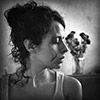 Elisa Rugo (Mexico, 1980). Lives and works in Mexico. She is a photographer, videographer and a specialist in visual communication with a degree in Creative Visualisation at the University of Communication. In 2012, she took part in the seminar Contemporary Photography at the Image Centre. She has participated in collective exhibitions in Pachuca, Querétaro, Guadalajara and Mexico-City. At the moment, she is the art director of the websites fpmeyer.com and museodemujeres.com and she is part of the editorial team of zonezero.com. You can see her work at: elisarugo.pro
Elisa Rugo (Mexico, 1980). Lives and works in Mexico. She is a photographer, videographer and a specialist in visual communication with a degree in Creative Visualisation at the University of Communication. In 2012, she took part in the seminar Contemporary Photography at the Image Centre. She has participated in collective exhibitions in Pachuca, Querétaro, Guadalajara and Mexico-City. At the moment, she is the art director of the websites fpmeyer.com and museodemujeres.com and she is part of the editorial team of zonezero.com. You can see her work at: elisarugo.proThat which I call my self-portrait is composed of thousands of days of work.
Each of them corresponds to the exact number and moment at which
I stopped as I painted after a task.
—Roman Opalka
Through the various forms of artistic expression over the last 500 years, the natural relationship born between the creator and his work tool has offered a rough testimony of self-exploration. We can see it from the self-portraits of Renaissance painters to the self-explorations produced by photographers opposite a mirror. The difference is that today we live in, thorough and for the image, and the image has driven us to communicate in a new way. Today, it has become a right to possess images of one’s self, and in this context the selfie appears to have emerged as a logical derivation of this human action.
Could we therefore consider selfies within the tradition of the self-portrait? Do they serve to search for, or develop, one’s identity? Let us begin with the idea that a selfie is not only a self-portrait in the traditional sense of the word. The selfie is created using a smart phone or webcam and places us in a spontaneous context or situation, showing its relative lack of preparation, but it also contains metadata that are commented on and shared repeatedly. This could define it as an emerging sub-genre of the self-portrait1, as taking this photographic image is in line with the new platforms of audiovisual communication.
However, the most appealing facet of this “new” trend is its social value. Current-day self-portraits do not seek to say this is me or this is how I am, as was done in times gone by to construct an identity, but rather they follow the logic of here I am or this is where I am. Being somewhere at a given moment prevails over just being. Persons therefore show themselves in a location, saying: this is where and how I am right now, with a mood: this is how I am today, or even, when in company: here I am with so-and-so. “Photography is not a memory, but an act”.2
The numerous self-portraits published every day construct visual diaries that show us multiple, plural and at the same time communal “private” stories. They are, in the digital era, the result of the democratization of the image, and acquire meaning once they are shared, not only among a specific group of persons (friends and/or relatives), but among all those who construct meaning through their interactions. The more active the exchange in networks, the stronger the links between their participants.
There are currently pages specializing in selfies that gather images in similar situations (selfiesatfunerals, selfieswithhomelesspeople, selfiesatseriousplaces, museumselfies.tumblr.com), projects that bring together collections of the (app.thefacesoffacebook, A través del espejo by Joan Fontcuberta), studies (selfiecity.net), new trends (Shaky Selfie), competitions, festivals (ClaroEcuador, Olimpiadas del selfie) and every day new apps appear that encourage us to tell a story by capturing images (Frontback). On many occasions film stars, musicians and celebrities such as the Pope or presidents express themselves through this medium, creating an intimate proximity with the public.
Taking photographs (of one’s self) has become an ordinary, everyday action. As Fontcuberta writes, it has become a compulsion. A vital compulsion in which each heartbeat becomes an image, such as the project The Whale Hunt, by Jonathan Harris, which uses 3,214 timed photographs to show in frequencies the most powerful moments of his experience of whale hunting. We are in an era that strives to photograph everything and create an interaction, in a context in which the photographic image has become a desire to speak. May nothing remain unrecorded or unshared! as we only exist insofar as we are present online.
What then of privacy? The intimate has become public. In 2000, a performance was presented called Nautilus, casa transparente.3 It consisted of a space with translucent walls in which a person was carrying out their daily life. People, some curious, others outraged, spend hours obsessively observing this person in his ordinary intimacy, as though he were an animal in a zoo. A few years later, and thanks to photography and its connectivity, we appear to be putting ourselves in this person’s place willingly and living in our own glass houses, exhibiting our everyday life without fear or prejudice.
Today’s democratized self-portrait is a public declaration carrying the message of our identity. The numerous devices and platforms used to communicate through the image enable us to react and create the need to leave a trace, in order for others to discover us. The selfie has become a social phenomenon of self-expression that can be as diverse as humanity itself, but we do not know to what extent social or cultural experiences are measured by the endless software. We are therefore invited to continue to take portraits of ourselves until technology becomes insufficient and we exceed the mobility, ubiquity and connection offered by the fifth moment of photography.4



























1 Tifentale, Alise. The Selfie: Making sense of the “Masturbation of Self-Image” and the “Virtual Mini-Me”. February 2014 / selfiecity.net
2 Fontcuberta, Joan. Quote from Joan Fontcuberta: el post-talento fotográfico. February 2014 by Galcerán de Born
3 Nautilus, casa transparente, an original idea by the Chilean architect Arturo Torres
4 The fifth momento of photography explores the effect of the iphone on photography, the technological 'mash-up' with the internet and omnipresent social connectivity. Edgar Gómez, and Eric T. Meyer. Creation and Control in the Photographic Process: iPhones and the Emerging Fifth Moment of Photography. Photographies 5, number 2 (2012): 203-221.
 Vanessa Alcaíno Pizani (Venezuela, 1980). Lives and works in Mexico. Visual artist. She graduated in Philosophy at the Central University of Venezuela and has a Master’s degree in Spanish and Latin American Thought at the Autonomous University of Madrid (UAM). Since 1994, she has worked in the field of photography at various institutions and organisations in Venezuela, Argentina and Mexico. At the moment, she is part of the editorial team of zonezero.com. You can see her work at: vanessapizani
Vanessa Alcaíno Pizani (Venezuela, 1980). Lives and works in Mexico. Visual artist. She graduated in Philosophy at the Central University of Venezuela and has a Master’s degree in Spanish and Latin American Thought at the Autonomous University of Madrid (UAM). Since 1994, she has worked in the field of photography at various institutions and organisations in Venezuela, Argentina and Mexico. At the moment, she is part of the editorial team of zonezero.com. You can see her work at: vanessapizani Elisa Rugo (Mexico, 1980). Lives and works in Mexico. She is a photographer, videographer and a specialist in visual communication with a degree in Creative Visualisation at the University of Communication. In 2012, she took part in the seminar Contemporary Photography at the Image Centre. She has participated in collective exhibitions in Pachuca, Querétaro, Guadalajara and Mexico-City. At the moment, she is the art director of the websites fpmeyer.com and museodemujeres.com and she is part of the editorial team of zonezero.com. You can see her work at: elisarugo.pro
Elisa Rugo (Mexico, 1980). Lives and works in Mexico. She is a photographer, videographer and a specialist in visual communication with a degree in Creative Visualisation at the University of Communication. In 2012, she took part in the seminar Contemporary Photography at the Image Centre. She has participated in collective exhibitions in Pachuca, Querétaro, Guadalajara and Mexico-City. At the moment, she is the art director of the websites fpmeyer.com and museodemujeres.com and she is part of the editorial team of zonezero.com. You can see her work at: elisarugo.proNatan Dvir


Coming Soon
In recent years, a kaleidoscopic net of huge billboards has enveloped the commercial hubs of New York City. The branding of the cityscape has become so ubiquitous, that the colorful, monumental advertisements, looming over the narrow streets, seem to be virtually unnoticed by the passersby. Giant billboards both dominate the urban landscape and blend into the background. Always in the peripheral vision, these ads turn the people moving through the space into passive spectators. The grasp is democratic and compulsory –the outdoor advertisements cannot be turned off and are able to reach a diverse public whose movements through the city momentarily overlap.
The effectiveness of outdoor billboards is juxtaposed with their impermanence; most are replaced after several weeks. The ephemeral nature, massive size and saturated colors of the ads create a fluid cinematic experience for the observer. People inhabiting the space underneath are pulled, unaware, into a staged set, the reality of the street merging with the commercial fantasy of the advertisements. Coming Soon is an exploration of our visual relationship with the branded city centers and the commercial environment we live in.




















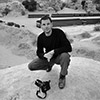 Natan Dvir (Nahariya, 1972). Lives in New York and works all around the world. He received a master’s degree in Business Administration from Tel Aviv University and a master´s degree in Photography from the School of Visual Arts, NY, after which he became a faculty member at the International Center for Photography (ICP). As a photographer he focuses on the human aspects of political, social and cultural issues. His work has been exhibited all over the world in solo and group exhibitions and has been published by leading international magazines.
Natan Dvir (Nahariya, 1972). Lives in New York and works all around the world. He received a master’s degree in Business Administration from Tel Aviv University and a master´s degree in Photography from the School of Visual Arts, NY, after which he became a faculty member at the International Center for Photography (ICP). As a photographer he focuses on the human aspects of political, social and cultural issues. His work has been exhibited all over the world in solo and group exhibitions and has been published by leading international magazines. [core_state] => 1 [core_access] => 1 [core_metadata] => {"robots":"","author":"Natan Dvir","rights":"","xreference":""} [core_created_user_id] => 841 [core_created_by_alias] => [core_created_time] => 2014-09-23 21:54:34 [core_images] => {"image_intro":"images\/categories\/open-content\/comingsoon.jpg","float_intro":"","image_intro_alt":"","image_intro_caption":"","image_fulltext":"images\/categories\/open-content\/comingsoon.jpg","float_fulltext":"","image_fulltext_alt":"","image_fulltext_caption":""} [core_modified_time] => 2016-06-22 18:25:52 [core_language] => en-GB [core_catid] => 37 [core_publish_up] => 2014-09-23 21:52:42 [core_publish_down] => 0000-00-00 00:00:00 [content_type_title] => Article [router] => ContentHelperRoute::getArticleRoute [author] => [author_email] => [link] => index.php?option=com_content&view=article&id=196:coming-soon&catid=37&lang=en-GB [displayDate] => 2014-09-23 21:52:42 [event] => stdClass Object ( [afterDisplayTitle] => [beforeDisplayContent] => [afterDisplayContent] => ) [text] =>


Coming Soon
In recent years, a kaleidoscopic net of huge billboards has enveloped the commercial hubs of New York City. The branding of the cityscape has become so ubiquitous, that the colorful, monumental advertisements, looming over the narrow streets, seem to be virtually unnoticed by the passersby. Giant billboards both dominate the urban landscape and blend into the background. Always in the peripheral vision, these ads turn the people moving through the space into passive spectators. The grasp is democratic and compulsory –the outdoor advertisements cannot be turned off and are able to reach a diverse public whose movements through the city momentarily overlap.
The effectiveness of outdoor billboards is juxtaposed with their impermanence; most are replaced after several weeks. The ephemeral nature, massive size and saturated colors of the ads create a fluid cinematic experience for the observer. People inhabiting the space underneath are pulled, unaware, into a staged set, the reality of the street merging with the commercial fantasy of the advertisements. Coming Soon is an exploration of our visual relationship with the branded city centers and the commercial environment we live in.




















 Natan Dvir (Nahariya, 1972). Lives in New York and works all around the world. He received a master’s degree in Business Administration from Tel Aviv University and a master´s degree in Photography from the School of Visual Arts, NY, after which he became a faculty member at the International Center for Photography (ICP). As a photographer he focuses on the human aspects of political, social and cultural issues. His work has been exhibited all over the world in solo and group exhibitions and has been published by leading international magazines.
Natan Dvir (Nahariya, 1972). Lives in New York and works all around the world. He received a master’s degree in Business Administration from Tel Aviv University and a master´s degree in Photography from the School of Visual Arts, NY, after which he became a faculty member at the International Center for Photography (ICP). As a photographer he focuses on the human aspects of political, social and cultural issues. His work has been exhibited all over the world in solo and group exhibitions and has been published by leading international magazines. [id] => 196 [language] => en-GB [catid] => 37 [jcfields] => Array ( ) ) 1
Bruno Bresani






















 Bruno Bresani (Brasil, 1973). Lives and works in Mexico. Photographer. He has completed three masters: Production and Artistic Research at the University of Barcelona, Digital Arts at the University Pompeu Fabra and Visual Arts at the National School of Plastic Arts at the UNAM. He has participated in several festivals and exhibitions in various cities in Mexico, the United Kingdom, Portugal, Austria, Argentina, Colombia, Morocco, Cuba and Spain. To see more of his work go to: brunobresani.blogspot.mx/
Bruno Bresani (Brasil, 1973). Lives and works in Mexico. Photographer. He has completed three masters: Production and Artistic Research at the University of Barcelona, Digital Arts at the University Pompeu Fabra and Visual Arts at the National School of Plastic Arts at the UNAM. He has participated in several festivals and exhibitions in various cities in Mexico, the United Kingdom, Portugal, Austria, Argentina, Colombia, Morocco, Cuba and Spain. To see more of his work go to: brunobresani.blogspot.mx/





















 Bruno Bresani (Brasil, 1973). Lives and works in Mexico. Photographer. He has completed three masters: Production and Artistic Research at the University of Barcelona, Digital Arts at the University Pompeu Fabra and Visual Arts at the National School of Plastic Arts at the UNAM. He has participated in several festivals and exhibitions in various cities in Mexico, the United Kingdom, Portugal, Austria, Argentina, Colombia, Morocco, Cuba and Spain. To see more of his work go to: brunobresani.blogspot.mx/
Bruno Bresani (Brasil, 1973). Lives and works in Mexico. Photographer. He has completed three masters: Production and Artistic Research at the University of Barcelona, Digital Arts at the University Pompeu Fabra and Visual Arts at the National School of Plastic Arts at the UNAM. He has participated in several festivals and exhibitions in various cities in Mexico, the United Kingdom, Portugal, Austria, Argentina, Colombia, Morocco, Cuba and Spain. To see more of his work go to: brunobresani.blogspot.mx/Pyuupiru
The search of an ideal self
by Annemarie Bas
Speaking of the theme of this issue, Liquid Identity, one could say Pyuupiru is its embodiment. She was born as a male, but gradually realised that she didn’t feel comfortable with her body. She started wearing eccentric costumes that distorted her figure. And in 2007 she decided to take it a step further and get sex reassignment surgery, an experience that inspired her Self-portrait Series.
Identity, for Pyuupiru, is something that is constantly being developed and changed. In an interview she said:
“As time goes by, we grow both qualitatively and quantitatively, expanding our capacity. We continue to add various elements and new points of view to our personality, until we are like a bunch of grapes. I think this is the life of people from birth to death.”1
In this way, identity is not a fixed quality, one is constantly adding new elements to one’s personality, moulding it, giving it a new shape, perfecting it, searching for an ideal self. This process is not limited to the mind. The body can also be reshaped, so that it is in harmony with one’s identity.
Pyuupiru described the relationship between body and identity as follows:
“For me, the body is like a vase made of fragile glass. Liquid is an emotion of various colours poured in the vase, and identity is a will to make one pour the liquid into it. You know that the glass changes its shape when heat is added. And you know you choose what you wear by your will. Just like that I’ve transformed my body by my will, both internally and externally. It required me to reveal my very emotion. Emotion is just like a heat having various temperatures, and everyone has it.”2
The discord between body and mind, that Pyuupiru had felt since childhood, has been an incentive for her to make art. In her artistic work, her life experiences and emotions are vital. She keeps them bottled inside of her until they boil, provoking a creative explosion which is then transformed into art.
When she made the Self-portrait Series, she thought of the oppression she felt due to her gender dilemmas: first she thought of her memories and experiences of pain, such as her memories of boyhood and the nightmares caused by hormone replacement therapy and psychoactive drugs. She focused on them up to the point where she felt she had re-lived the suffering enough. Then she filtered those memories and experiences through her sense of beauty in order to be able to shape the characters in her work from the inside and the outside. After that, Pyuupiru, photographed and materialised these characters.
The result is a series of self-portraits which are very intense and personal (despite the fact that in some of the portraits she hides her face with cosmetics, wigs and masks). Exposing her true identity in this way, Pyuupiru tells us, came with a heavy price. Even so, she feels that an artist can gain a pleasure from this exploration that is beyond its costs. Therefore she will certainly continue to share her experiences and feelings through her art in a constant quest to come to grips with the mystery of identity.
1. Fleur Pierets, Pyuupiru in: Et Alors? Magazine, magazine special: GenderBlender (jun.-ago. 2014) 32-39, p.39.
http://issuu.com/etalorsmagazinespecials/docs/genderblender_issuu
2. Owen Leong, Interview with Pyuupiru in: Peril, Asian-Australian Arts and Culture, no. 8 - Why are people so unkind? (nov. 2009).
http://peril.com.au/back-editions/edition08/interview-with-pyuupiru/
 Annemarie Bas (The Netherlands, 1986), has a Bachelor’s degree in History at the University of Utrecht and a Master’s degree in Cultural History at the same institution. As a historian, she worked as a junior researcher at the Museum of Psychiatry "Het Dolhuys" in Haarlem, The Netherlands. Since 2013, she lives and works in Mexico City. At the moment, she is international liaison at ZoneZero and works as an independent translator.
Annemarie Bas (The Netherlands, 1986), has a Bachelor’s degree in History at the University of Utrecht and a Master’s degree in Cultural History at the same institution. As a historian, she worked as a junior researcher at the Museum of Psychiatry "Het Dolhuys" in Haarlem, The Netherlands. Since 2013, she lives and works in Mexico City. At the moment, she is international liaison at ZoneZero and works as an independent translator.







































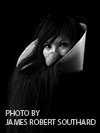 Pyuupiru (Japan, 1974). Lives and works in Tokyo. At the moment, she uses various media: installations, movies, performances, portraiture and sculpture. She works with opposed concepts like life-death, men-women, one-other. She participated in many exhibitions and performances, also on an international level. Besides being a contemporary artist, she works in a wide range of fields like art direction, character design, costume design and writing. You can see more of her work on: pyuupiru.com.
Pyuupiru (Japan, 1974). Lives and works in Tokyo. At the moment, she uses various media: installations, movies, performances, portraiture and sculpture. She works with opposed concepts like life-death, men-women, one-other. She participated in many exhibitions and performances, also on an international level. Besides being a contemporary artist, she works in a wide range of fields like art direction, character design, costume design and writing. You can see more of her work on: pyuupiru.com.The search of an ideal self
by Annemarie Bas
Speaking of the theme of this issue, Liquid Identity, one could say Pyuupiru is its embodiment. She was born as a male, but gradually realised that she didn’t feel comfortable with her body. She started wearing eccentric costumes that distorted her figure. And in 2007 she decided to take it a step further and get sex reassignment surgery, an experience that inspired her Self-portrait Series.
Identity, for Pyuupiru, is something that is constantly being developed and changed. In an interview she said:
“As time goes by, we grow both qualitatively and quantitatively, expanding our capacity. We continue to add various elements and new points of view to our personality, until we are like a bunch of grapes. I think this is the life of people from birth to death.”1
In this way, identity is not a fixed quality, one is constantly adding new elements to one’s personality, moulding it, giving it a new shape, perfecting it, searching for an ideal self. This process is not limited to the mind. The body can also be reshaped, so that it is in harmony with one’s identity.
Pyuupiru described the relationship between body and identity as follows:
“For me, the body is like a vase made of fragile glass. Liquid is an emotion of various colours poured in the vase, and identity is a will to make one pour the liquid into it. You know that the glass changes its shape when heat is added. And you know you choose what you wear by your will. Just like that I’ve transformed my body by my will, both internally and externally. It required me to reveal my very emotion. Emotion is just like a heat having various temperatures, and everyone has it.”2
The discord between body and mind, that Pyuupiru had felt since childhood, has been an incentive for her to make art. In her artistic work, her life experiences and emotions are vital. She keeps them bottled inside of her until they boil, provoking a creative explosion which is then transformed into art.
When she made the Self-portrait Series, she thought of the oppression she felt due to her gender dilemmas: first she thought of her memories and experiences of pain, such as her memories of boyhood and the nightmares caused by hormone replacement therapy and psychoactive drugs. She focused on them up to the point where she felt she had re-lived the suffering enough. Then she filtered those memories and experiences through her sense of beauty in order to be able to shape the characters in her work from the inside and the outside. After that, Pyuupiru, photographed and materialised these characters.
The result is a series of self-portraits which are very intense and personal (despite the fact that in some of the portraits she hides her face with cosmetics, wigs and masks). Exposing her true identity in this way, Pyuupiru tells us, came with a heavy price. Even so, she feels that an artist can gain a pleasure from this exploration that is beyond its costs. Therefore she will certainly continue to share her experiences and feelings through her art in a constant quest to come to grips with the mystery of identity.
1. Fleur Pierets, Pyuupiru in: Et Alors? Magazine, magazine special: GenderBlender (jun.-ago. 2014) 32-39, p.39.
http://issuu.com/etalorsmagazinespecials/docs/genderblender_issuu
2. Owen Leong, Interview with Pyuupiru in: Peril, Asian-Australian Arts and Culture, no. 8 - Why are people so unkind? (nov. 2009).
http://peril.com.au/back-editions/edition08/interview-with-pyuupiru/
 Annemarie Bas (The Netherlands, 1986), has a Bachelor’s degree in History at the University of Utrecht and a Master’s degree in Cultural History at the same institution. As a historian, she worked as a junior researcher at the Museum of Psychiatry "Het Dolhuys" in Haarlem, The Netherlands. Since 2013, she lives and works in Mexico City. At the moment, she is international liaison at ZoneZero and works as an independent translator.
Annemarie Bas (The Netherlands, 1986), has a Bachelor’s degree in History at the University of Utrecht and a Master’s degree in Cultural History at the same institution. As a historian, she worked as a junior researcher at the Museum of Psychiatry "Het Dolhuys" in Haarlem, The Netherlands. Since 2013, she lives and works in Mexico City. At the moment, she is international liaison at ZoneZero and works as an independent translator.







































 Pyuupiru (Japan, 1974). Lives and works in Tokyo. At the moment, she uses various media: installations, movies, performances, portraiture and sculpture. She works with opposed concepts like life-death, men-women, one-other. She participated in many exhibitions and performances, also on an international level. Besides being a contemporary artist, she works in a wide range of fields like art direction, character design, costume design and writing. You can see more of her work on: pyuupiru.com.
Pyuupiru (Japan, 1974). Lives and works in Tokyo. At the moment, she uses various media: installations, movies, performances, portraiture and sculpture. She works with opposed concepts like life-death, men-women, one-other. She participated in many exhibitions and performances, also on an international level. Besides being a contemporary artist, she works in a wide range of fields like art direction, character design, costume design and writing. You can see more of her work on: pyuupiru.com.Xtabay Alderete
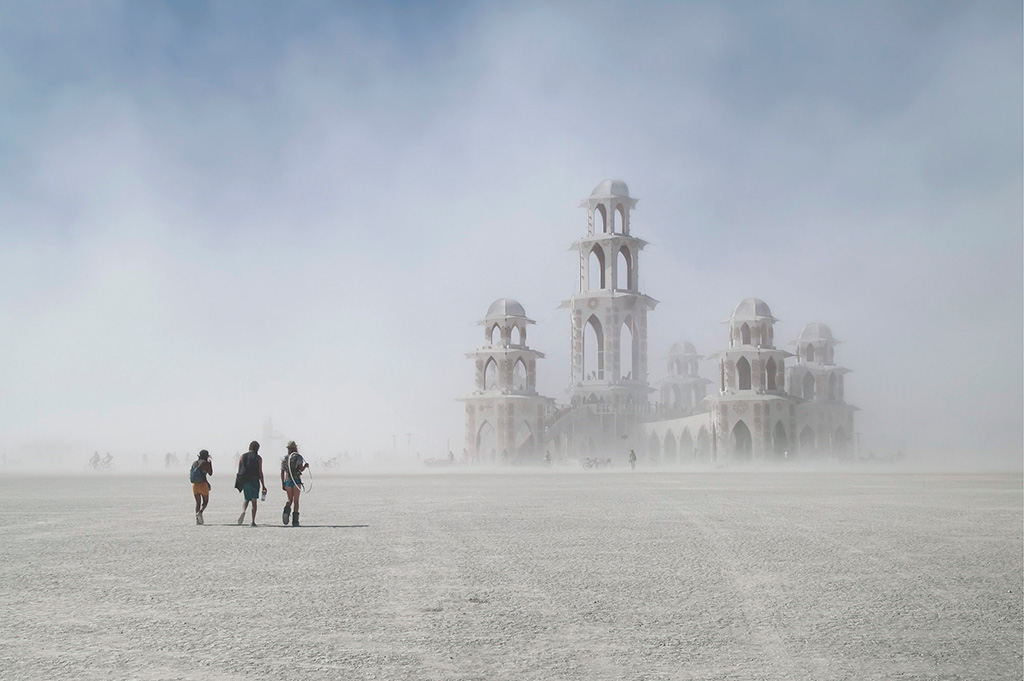

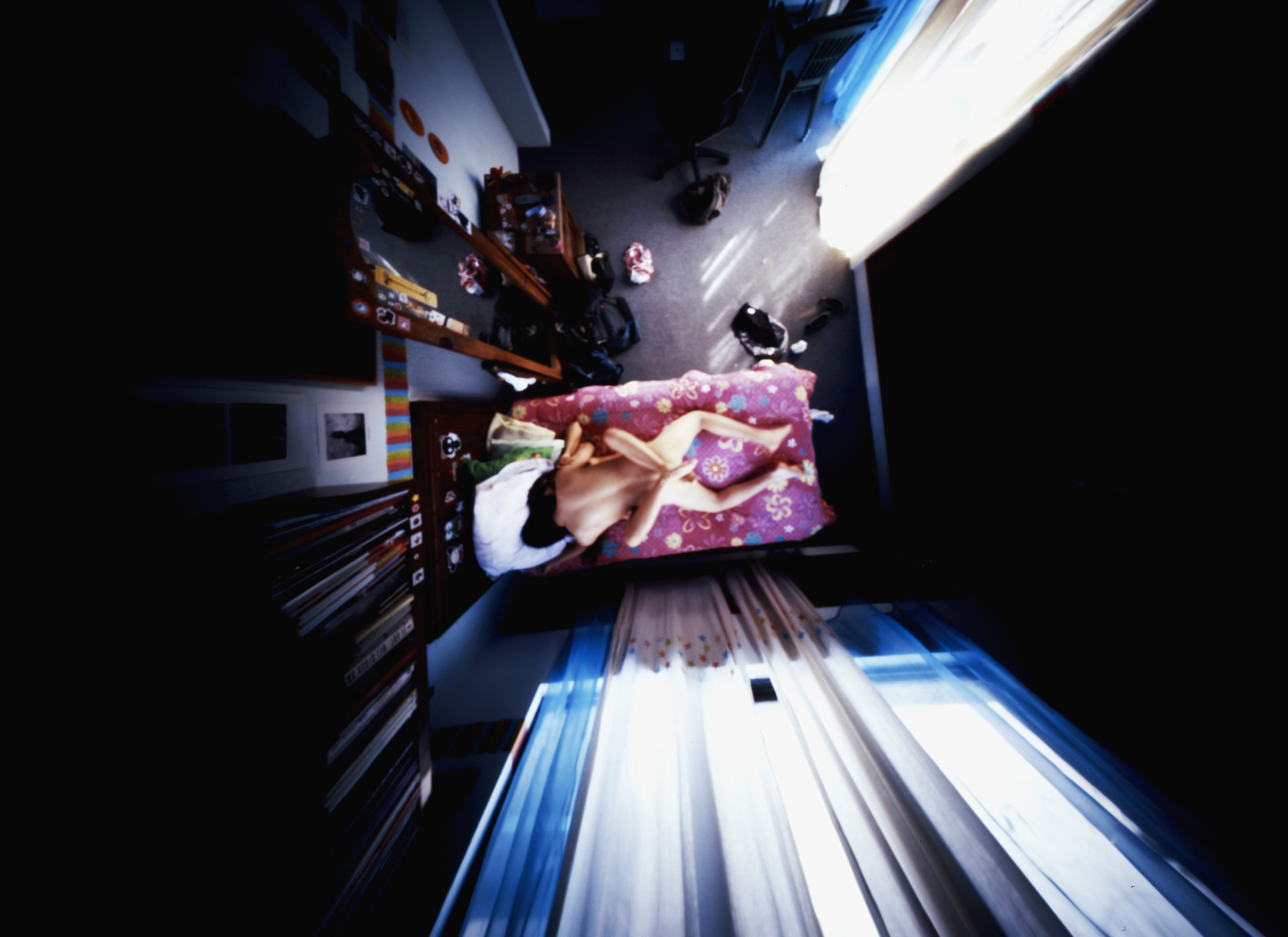
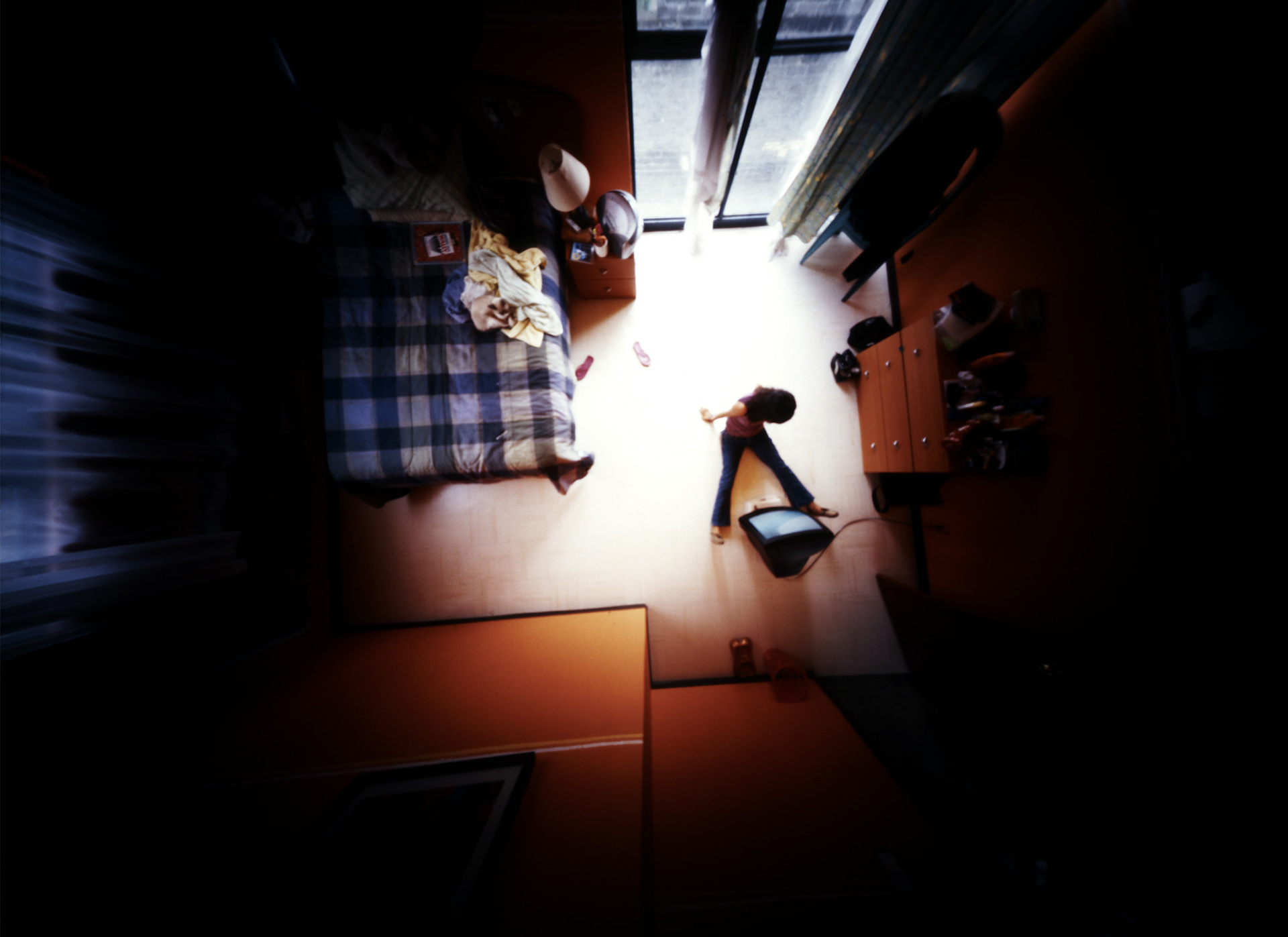
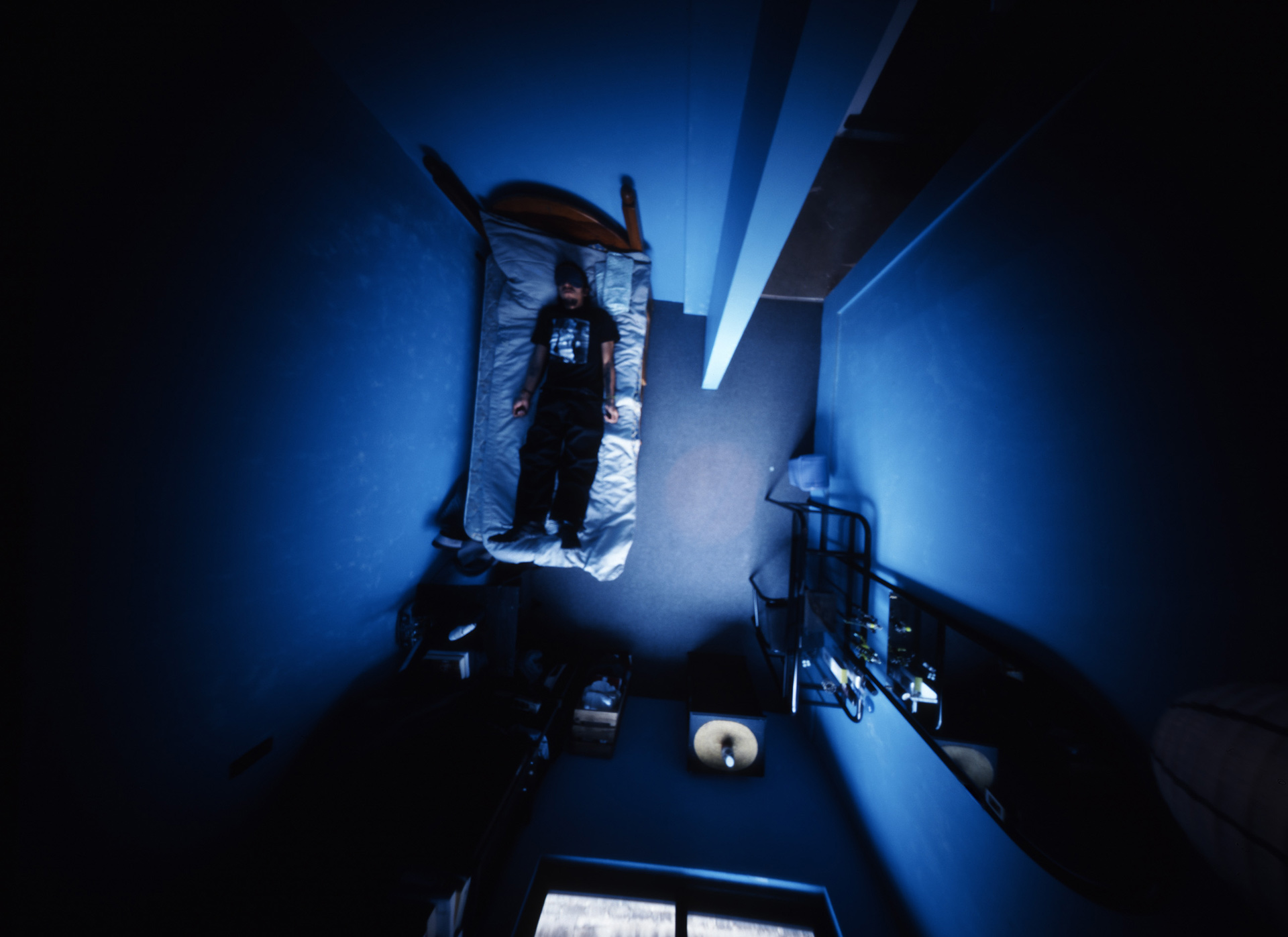
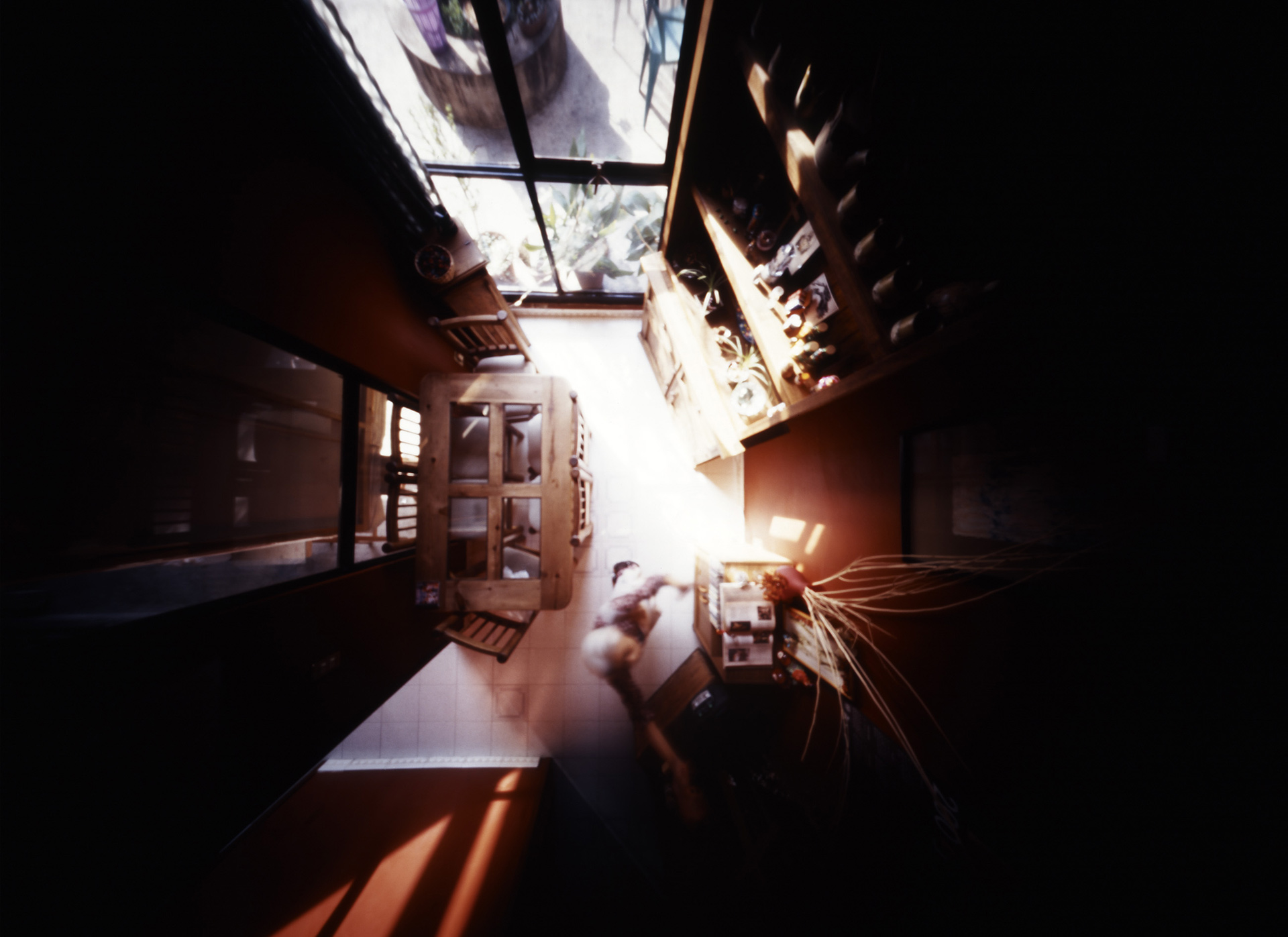
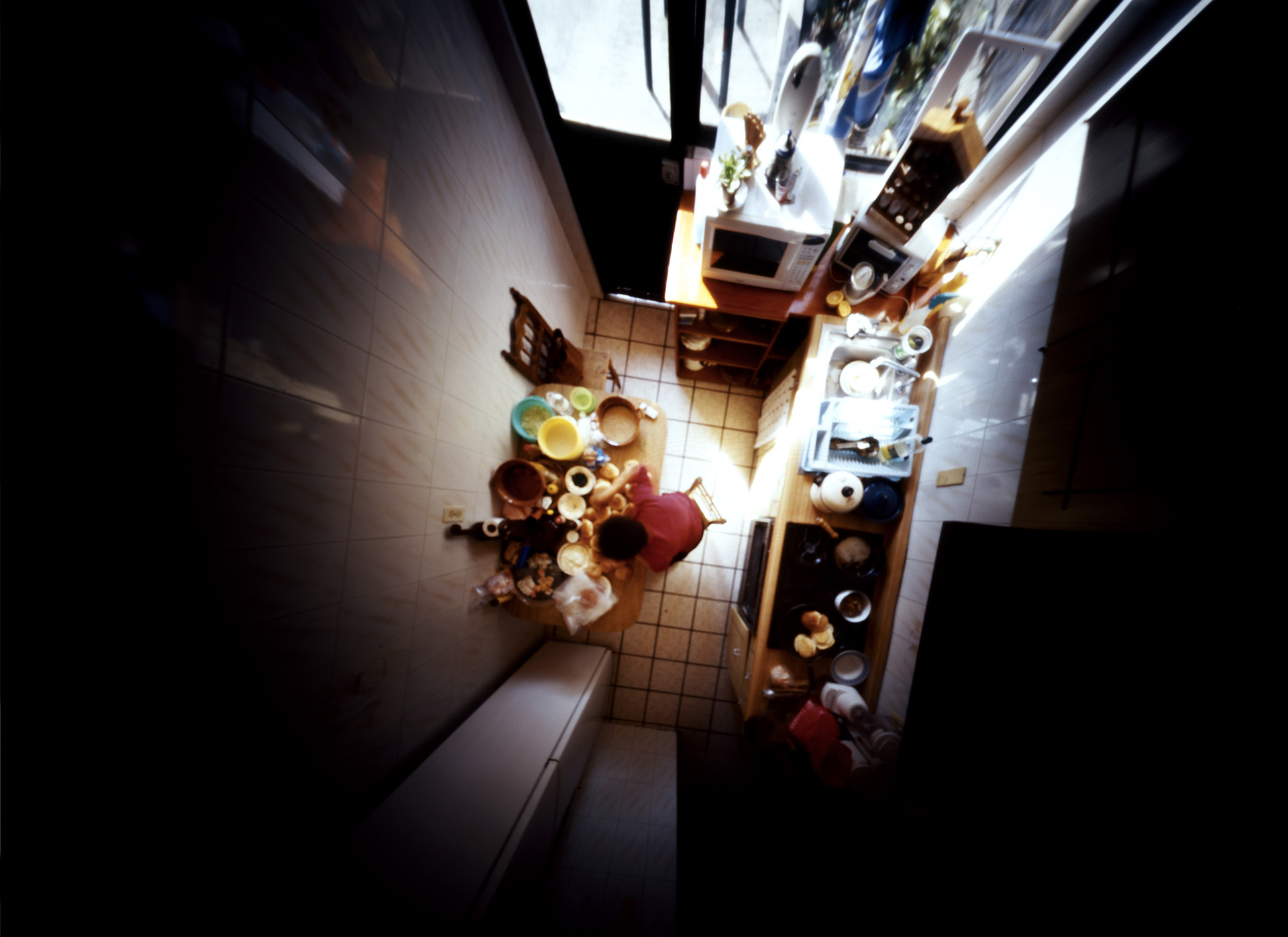
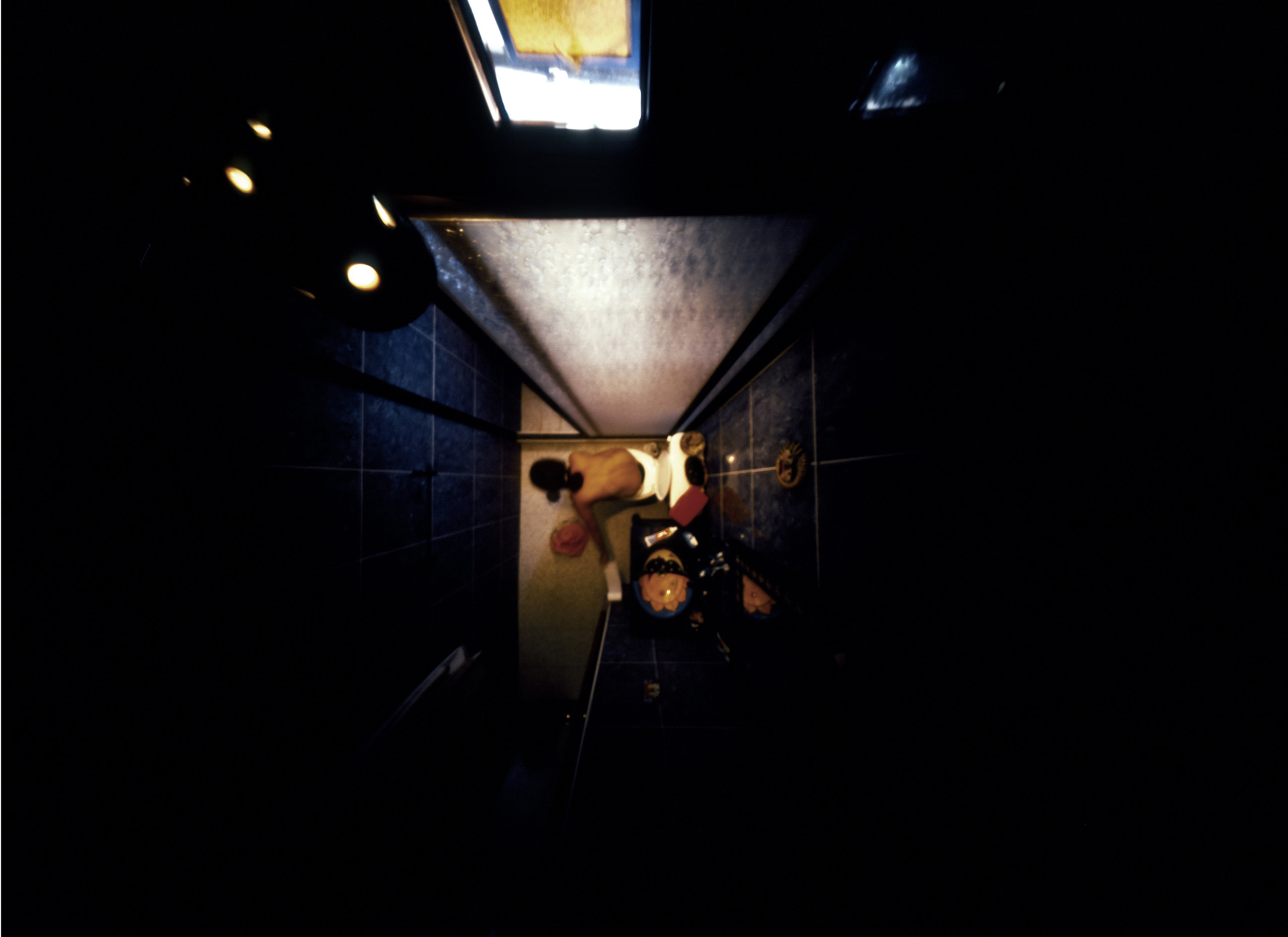
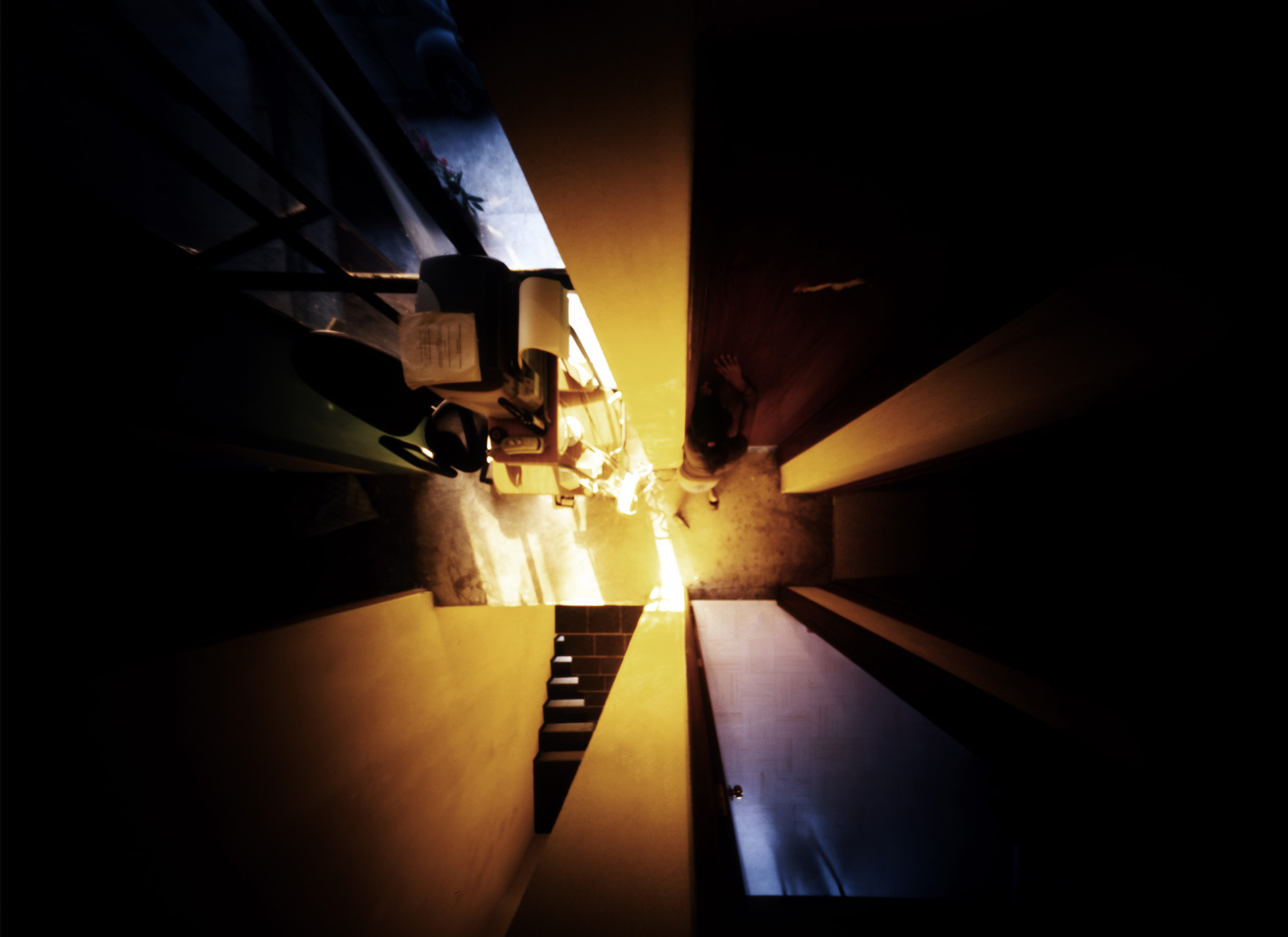
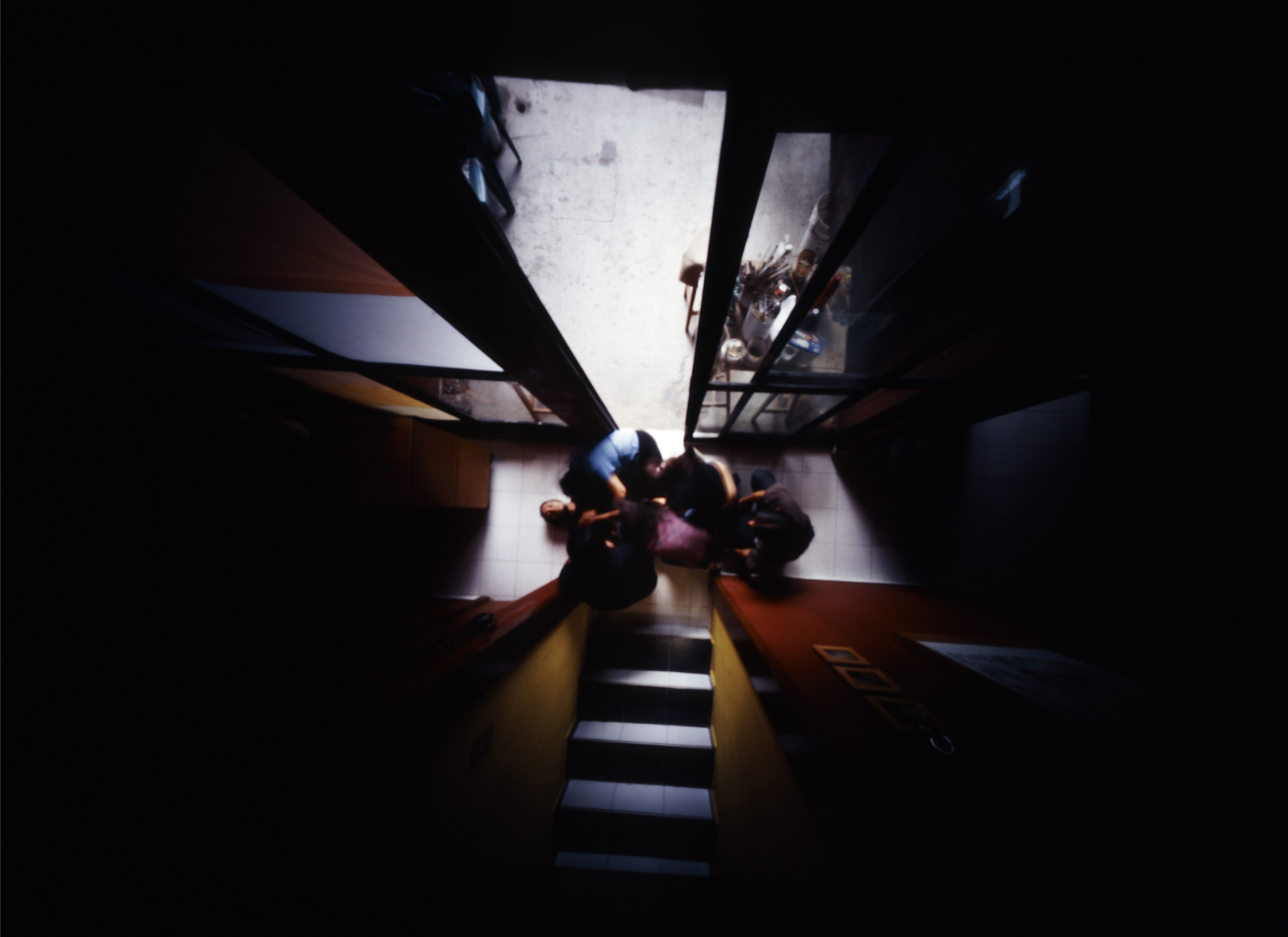
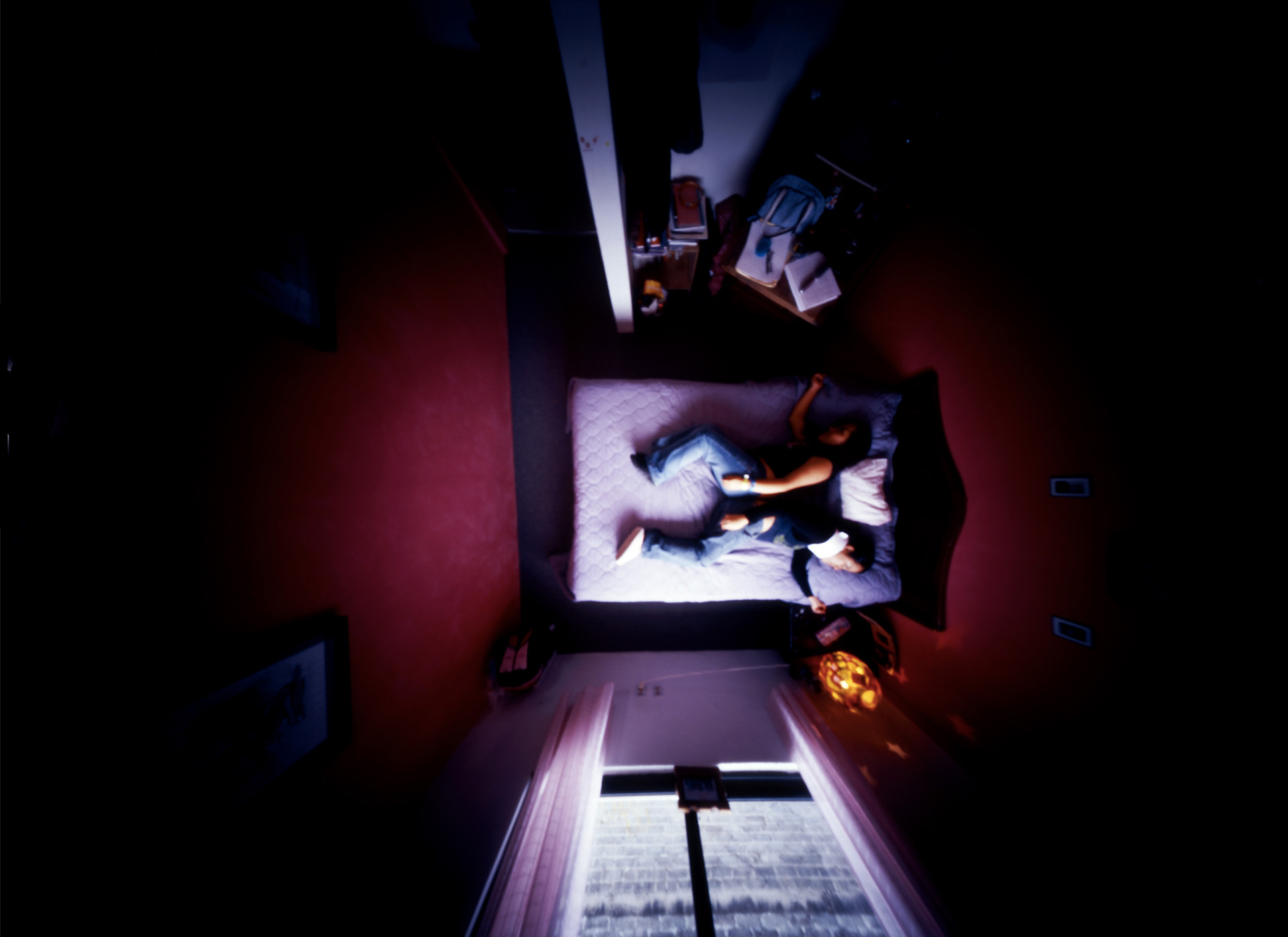
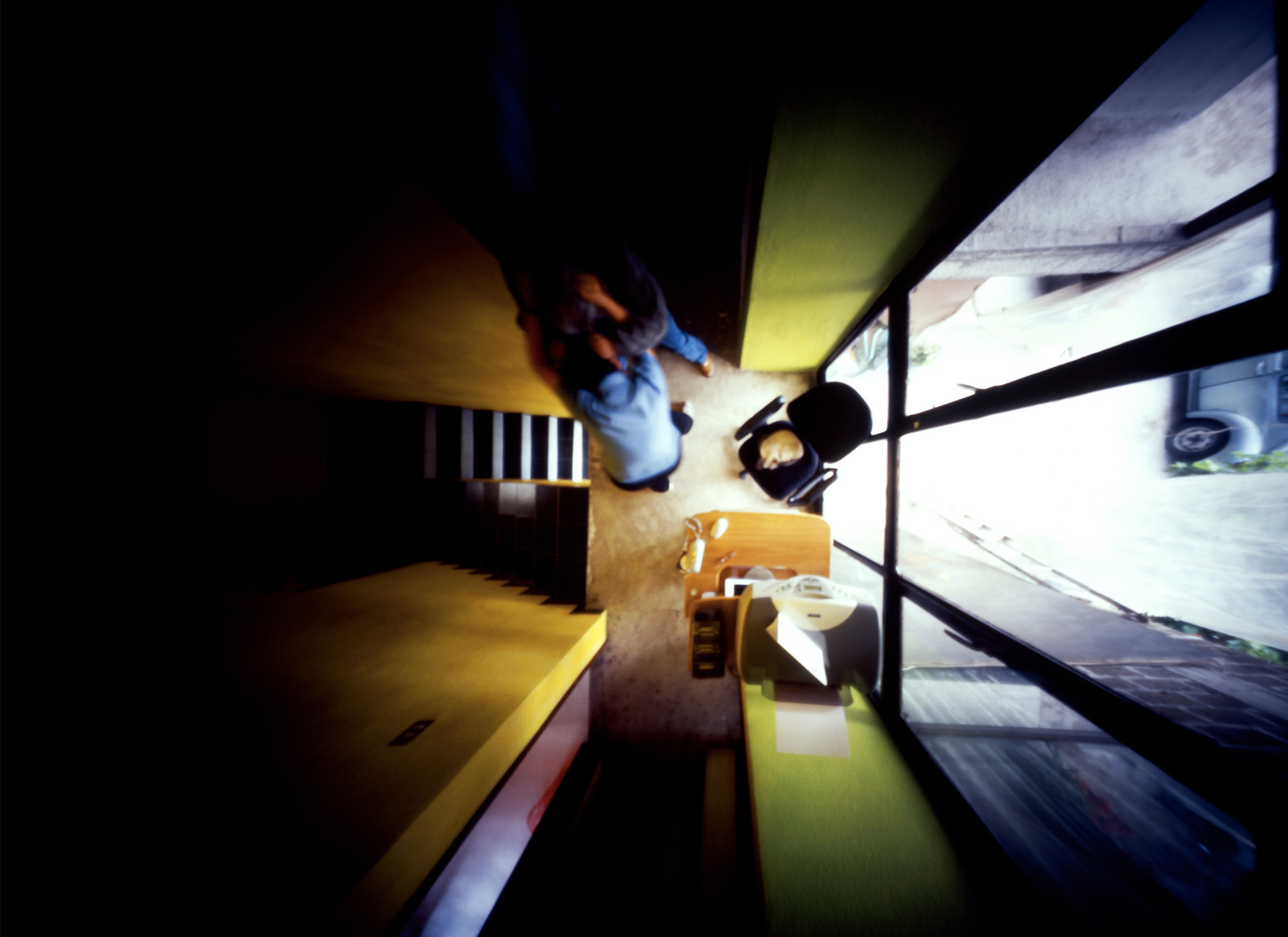
This project is based on the idea of the vigilant eye that threatens us to do no wrong. With this idea in mind, the author depicts her family environment, from conflicts to normal daily life, as if they were being monitored by a divine, human or mechanical being (God, spies or Big Brother). She presents these images from the point of view that each one of us is somehow controlled by a system, which reinforces the moral burden one feels when committing sins, crimes and mistakes.
The work presents daily life through images taken from different angles. With her handmade pinhole camera, the author establishes a certain feeling of omnipresence. She allows us to immerse ourselves in her experiences and the daily life between the walls of her home, giving the spectator a panoptic vision of her family as the so-called social unit of our times. Proving, in the end, that the society of the spectacle has encouraged a certain voyeurism through reality shows, which compel us to take sides and to judge the acts of the observed, and which puts us in the position of the divine being that tilts the scale of judgement towards the good or the bad.
We invite you to learn more about the preoccupations and the questionings of the author through this video.
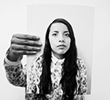 Xtabay Alderete (Mexico, 1979). Lives and works in Mexico City. Graduated from the School of Visual Arts, UNAM, with a bachelor´s degree in Visual Arts. At present, she studies a master in Visual Arts at the Academy of San Carlos, UNAM. Her artistic work focuses primarily on photography. In 2013 she took part in the exhibition (Re)Presentations, Contemporary Latin-American Photography, organised by PHotoEspaña, Madrid. Currently, she intervenes in landscapes that contain memory, oblivion, death and devastation, using objects.
Xtabay Alderete (Mexico, 1979). Lives and works in Mexico City. Graduated from the School of Visual Arts, UNAM, with a bachelor´s degree in Visual Arts. At present, she studies a master in Visual Arts at the Academy of San Carlos, UNAM. Her artistic work focuses primarily on photography. In 2013 she took part in the exhibition (Re)Presentations, Contemporary Latin-American Photography, organised by PHotoEspaña, Madrid. Currently, she intervenes in landscapes that contain memory, oblivion, death and devastation, using objects.











This project is based on the idea of the vigilant eye that threatens us to do no wrong. With this idea in mind, the author depicts her family environment, from conflicts to normal daily life, as if they were being monitored by a divine, human or mechanical being (God, spies or Big Brother). She presents these images from the point of view that each one of us is somehow controlled by a system, which reinforces the moral burden one feels when committing sins, crimes and mistakes.
The work presents daily life through images taken from different angles. With her handmade pinhole camera, the author establishes a certain feeling of omnipresence. She allows us to immerse ourselves in her experiences and the daily life between the walls of her home, giving the spectator a panoptic vision of her family as the so-called social unit of our times. Proving, in the end, that the society of the spectacle has encouraged a certain voyeurism through reality shows, which compel us to take sides and to judge the acts of the observed, and which puts us in the position of the divine being that tilts the scale of judgement towards the good or the bad.
We invite you to learn more about the preoccupations and the questionings of the author through this video.
 Xtabay Alderete (Mexico, 1979). Lives and works in Mexico City. Graduated from the School of Visual Arts, UNAM, with a bachelor´s degree in Visual Arts. At present, she studies a master in Visual Arts at the Academy of San Carlos, UNAM. Her artistic work focuses primarily on photography. In 2013 she took part in the exhibition (Re)Presentations, Contemporary Latin-American Photography, organised by PHotoEspaña, Madrid. Currently, she intervenes in landscapes that contain memory, oblivion, death and devastation, using objects.
Xtabay Alderete (Mexico, 1979). Lives and works in Mexico City. Graduated from the School of Visual Arts, UNAM, with a bachelor´s degree in Visual Arts. At present, she studies a master in Visual Arts at the Academy of San Carlos, UNAM. Her artistic work focuses primarily on photography. In 2013 she took part in the exhibition (Re)Presentations, Contemporary Latin-American Photography, organised by PHotoEspaña, Madrid. Currently, she intervenes in landscapes that contain memory, oblivion, death and devastation, using objects.Dina Litovsky


The barren emptiness of the desert is devoid of sentiment. There is no poetry in the dried up surface, no melancholy stirred up by the gusts of fine sand. On a beach or in a forest, in a green field or in an architectural wonder of a city, one is overwhelmed by the beauty of the environment, the lyricism of associations and memories. But in the sudden vacuum of a desert whiteout there is only isolation.
As the sun is blocked out by the dust and the horizon is swept away, the first anxious moment of helplessness metamorphoses into a feeling of unbounded freedom. In this vast, disorienting silence, one is left entirely to the immediacy of the experience.
It is rare to find a space lacking the external noise of over-stimulation. But it is necessary in order to hear oneself better. The isolation of the whiteout brings introspection and resets the senses. The sterility of the desert becomes an oasis.

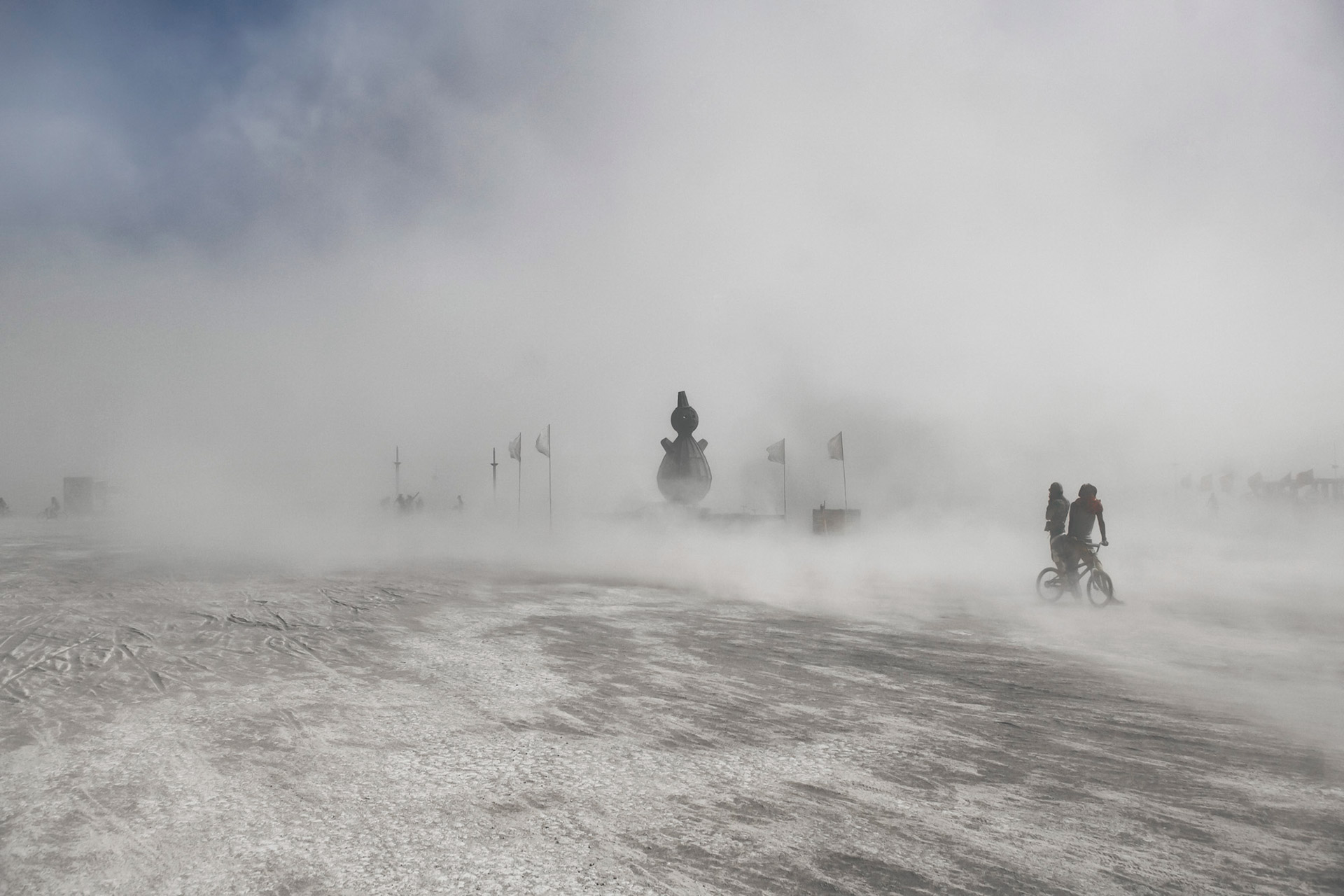
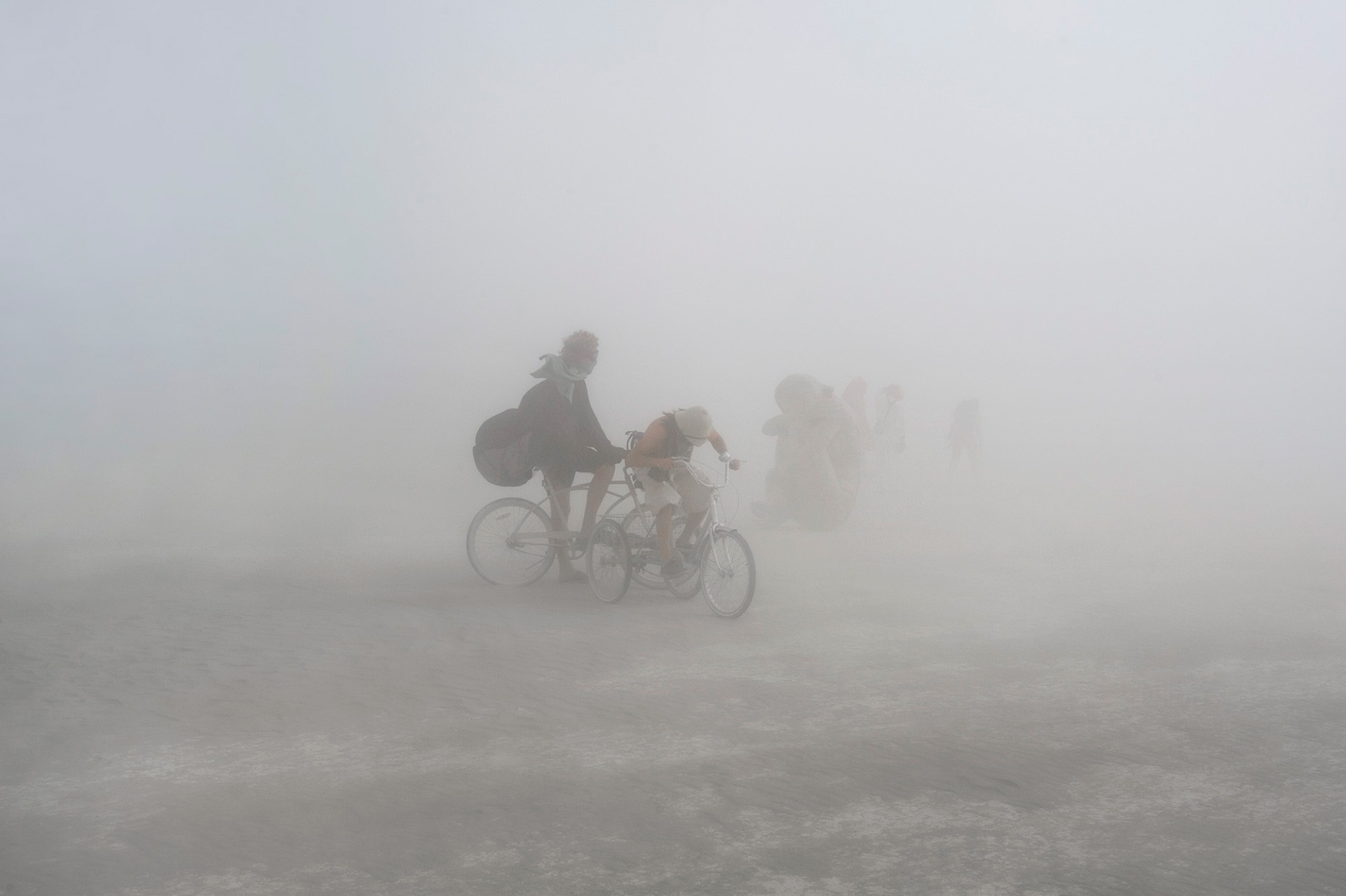
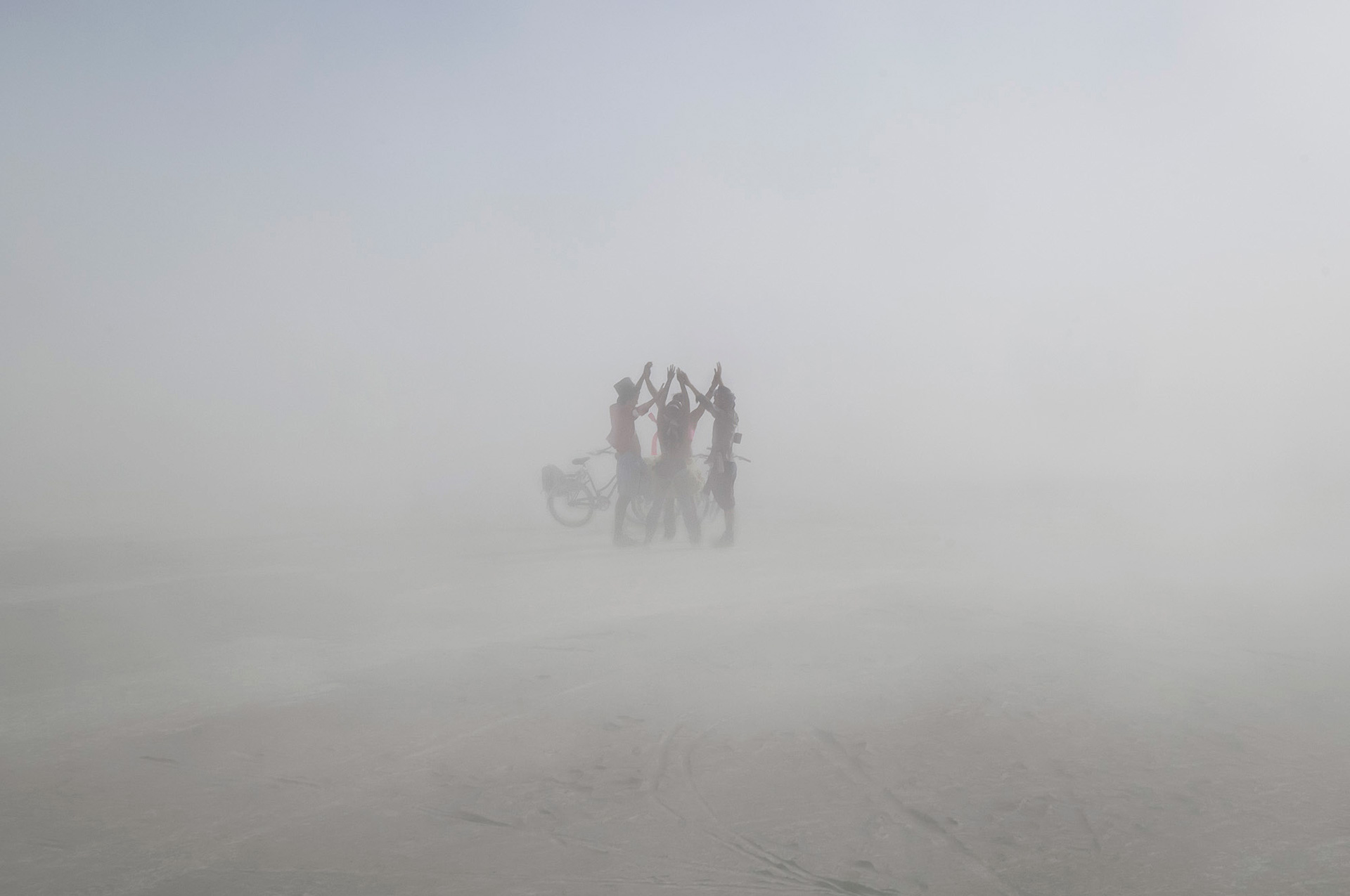
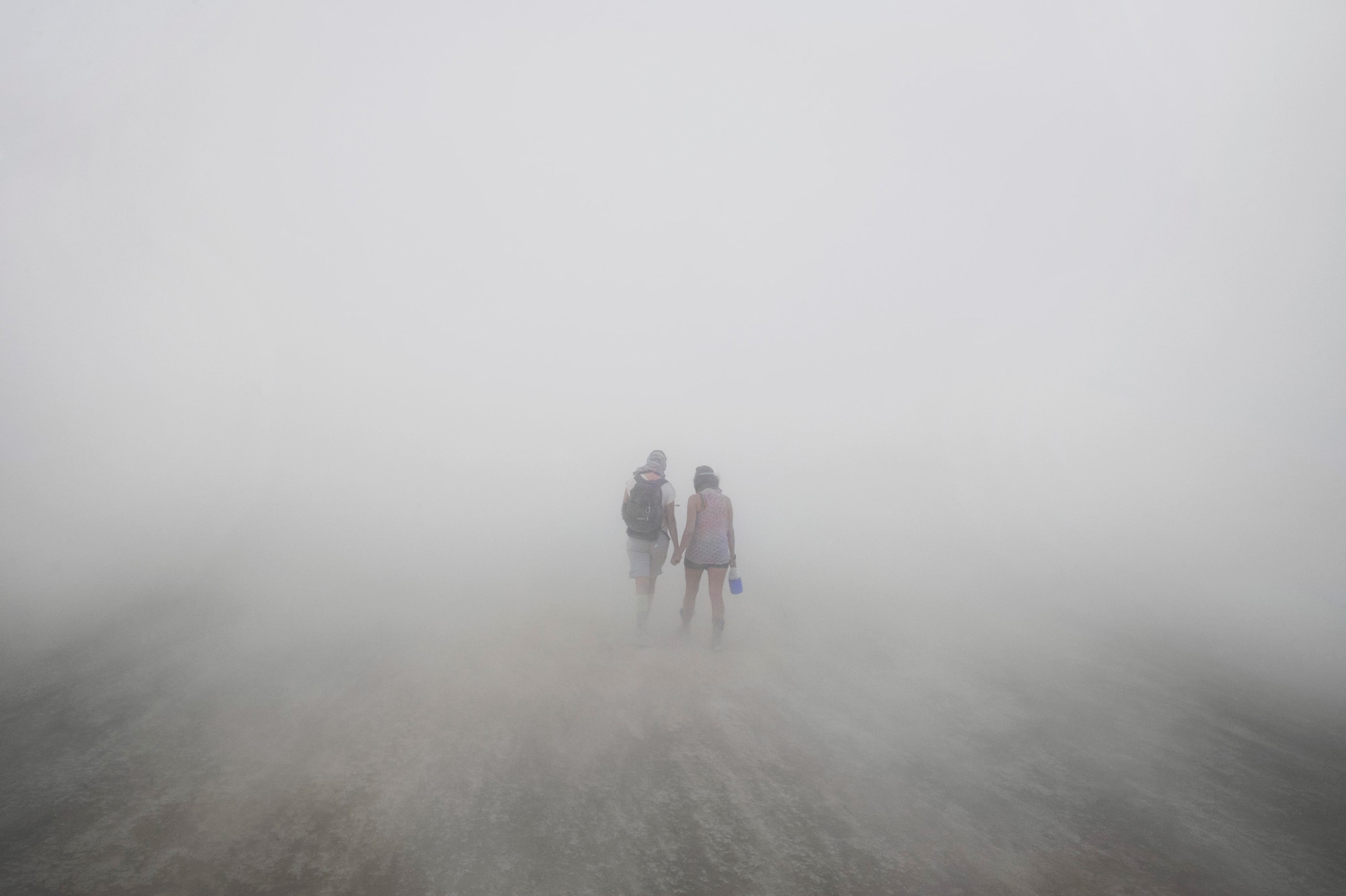
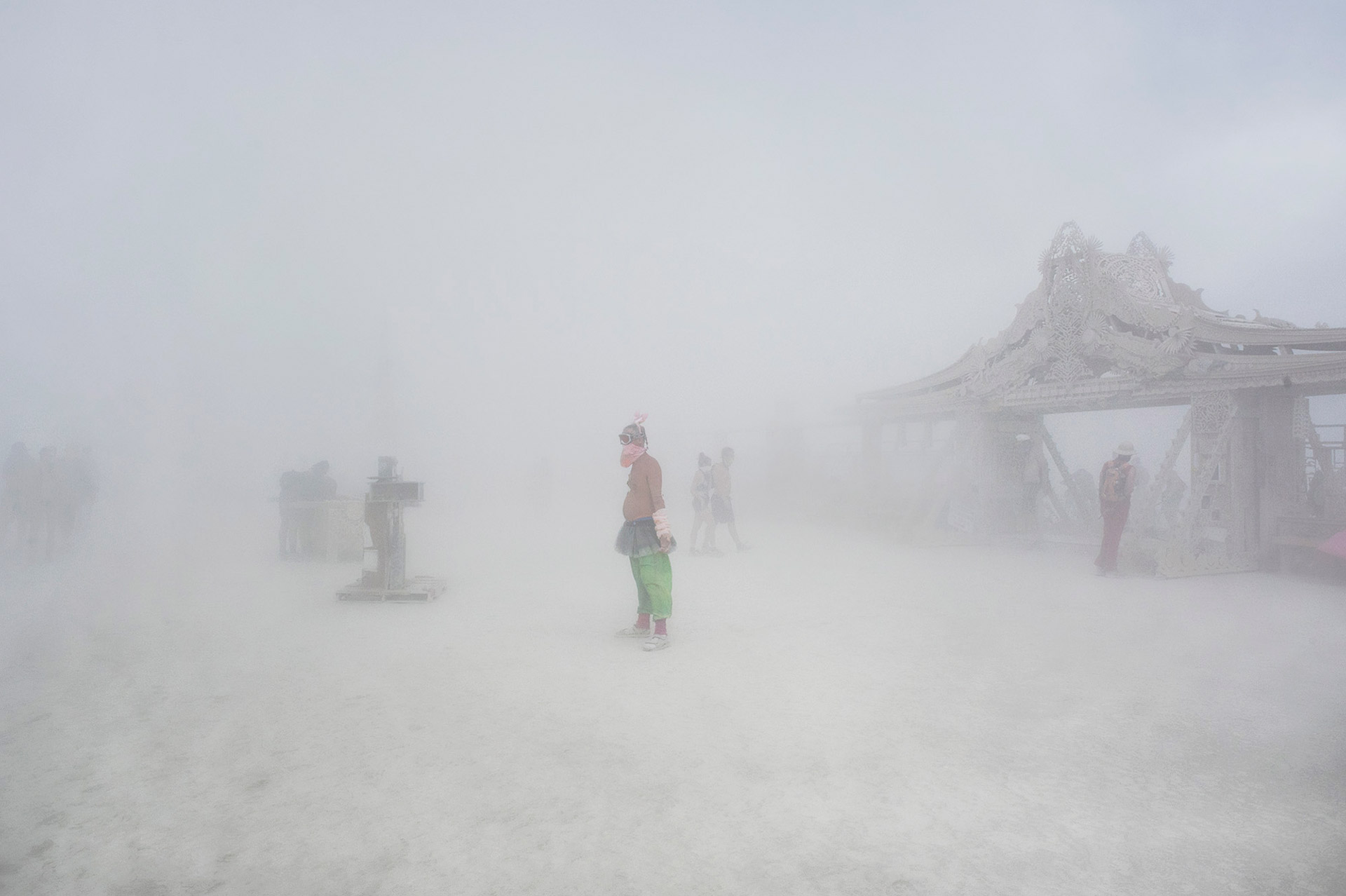
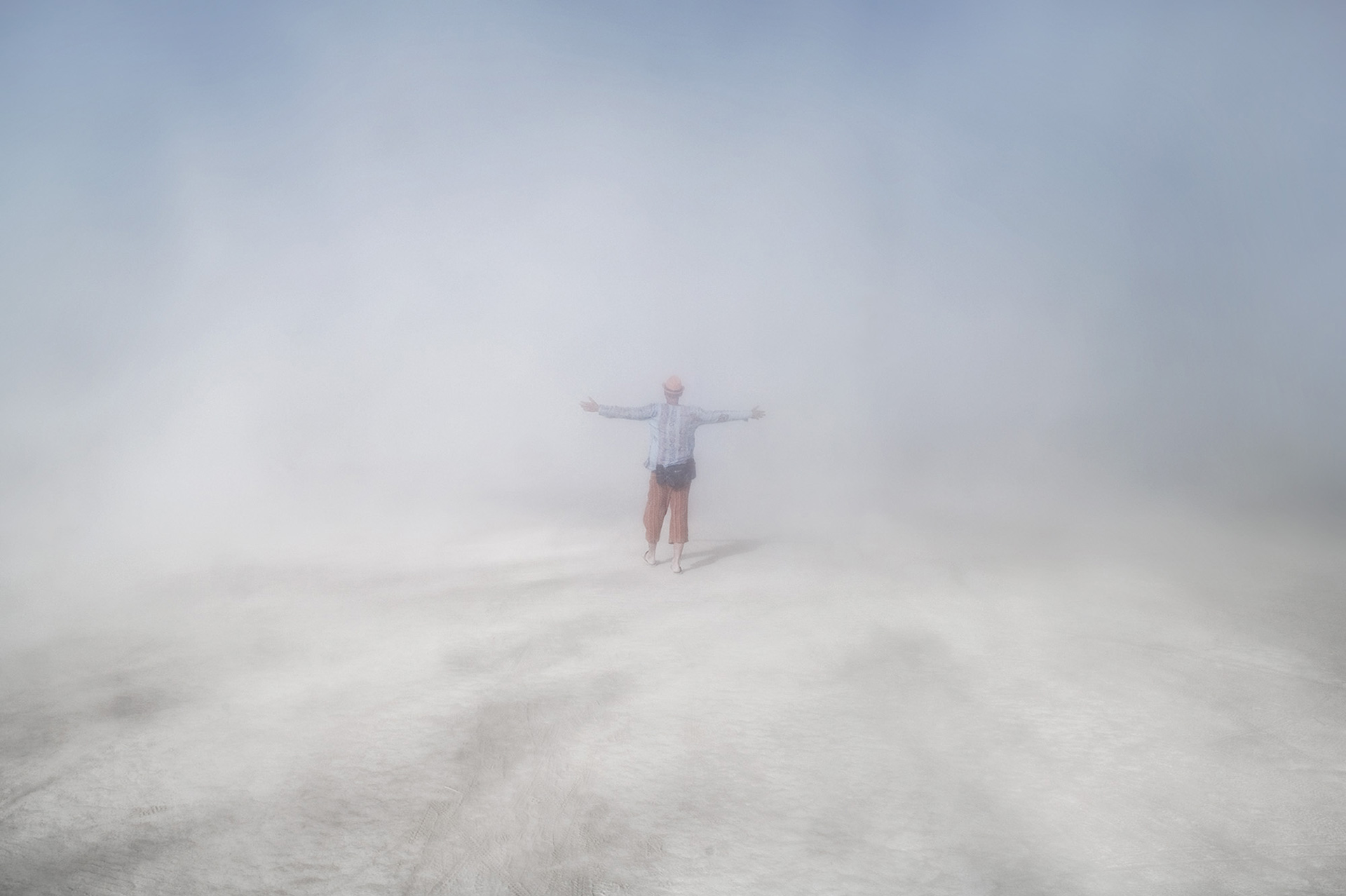
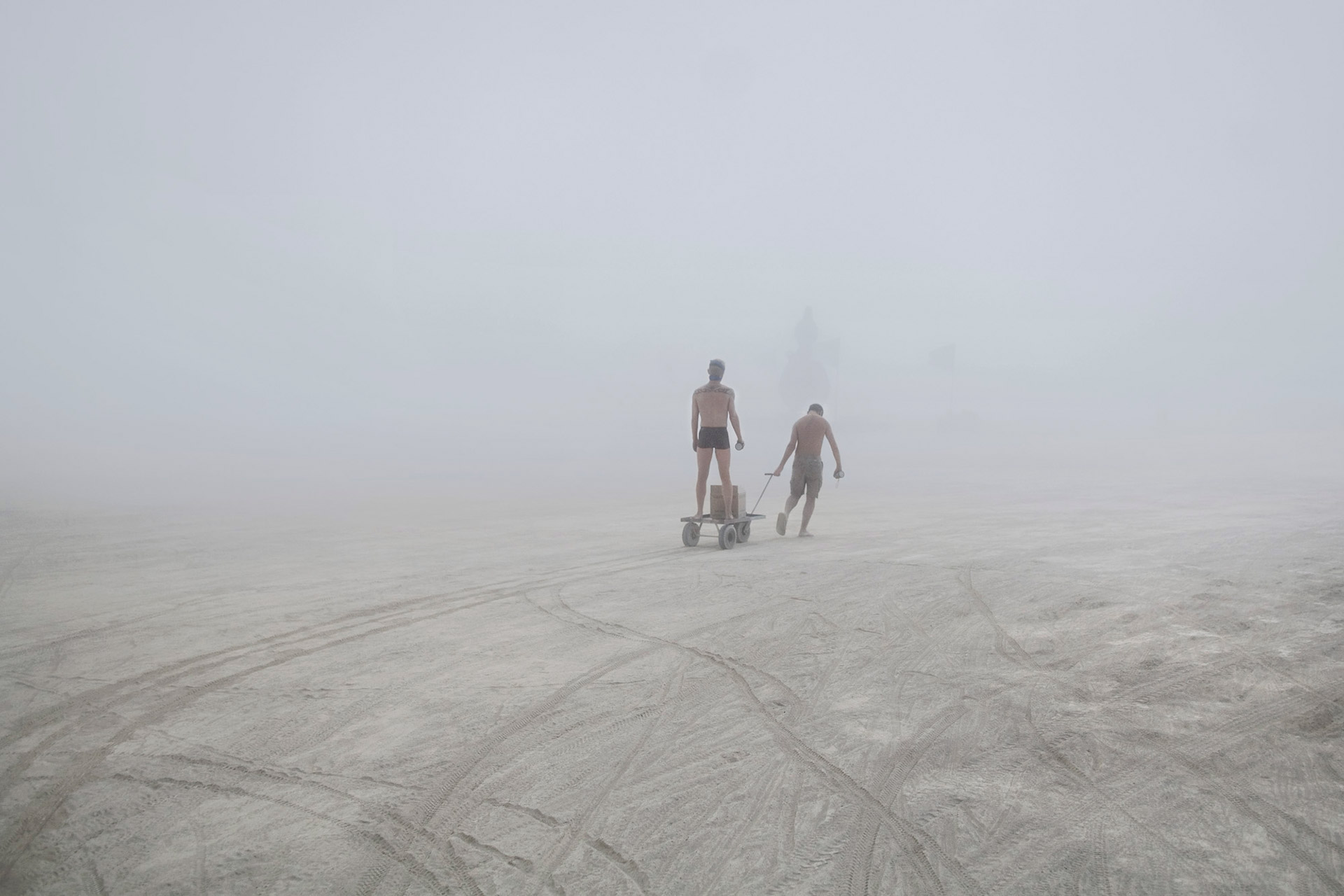
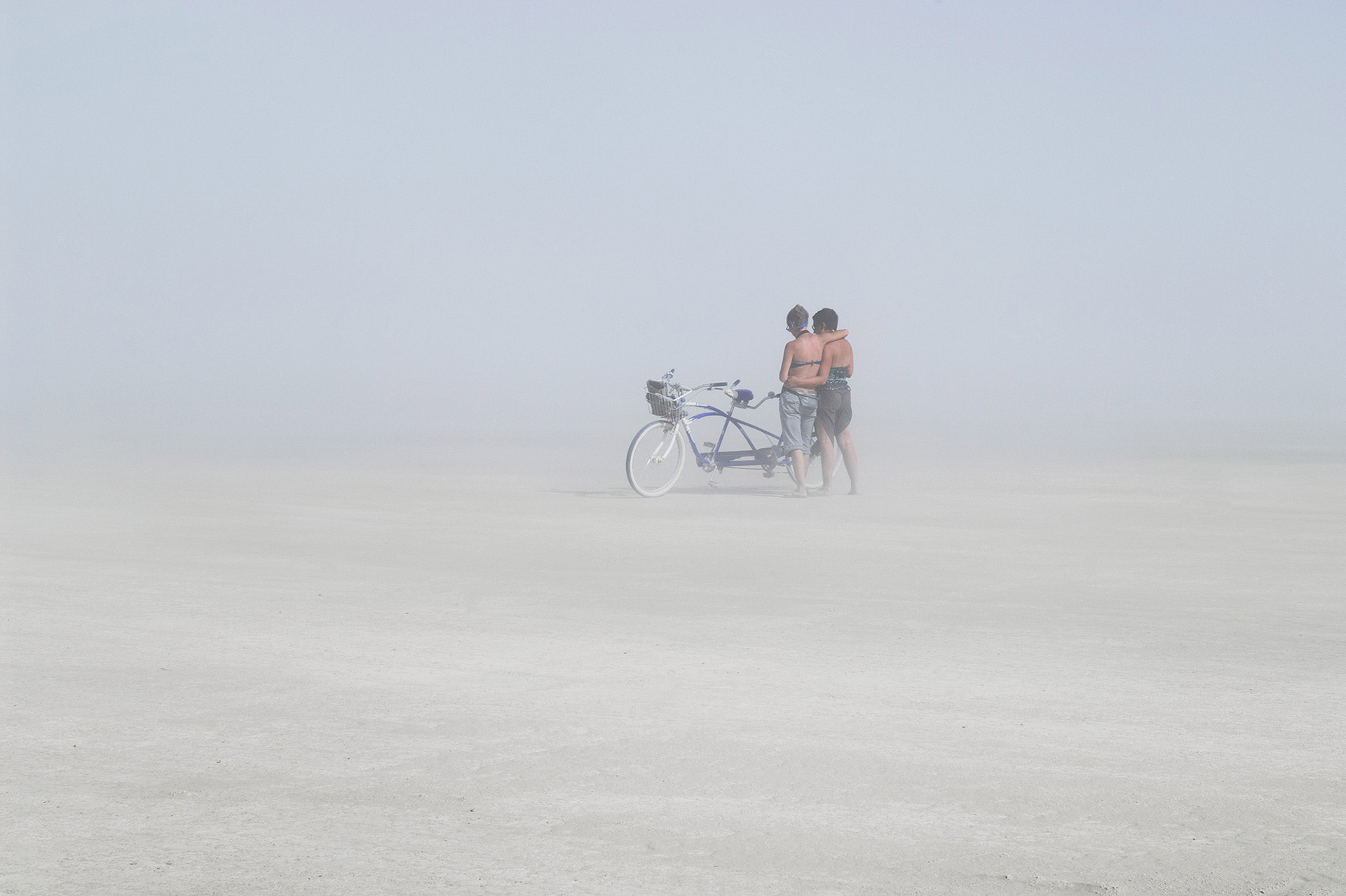
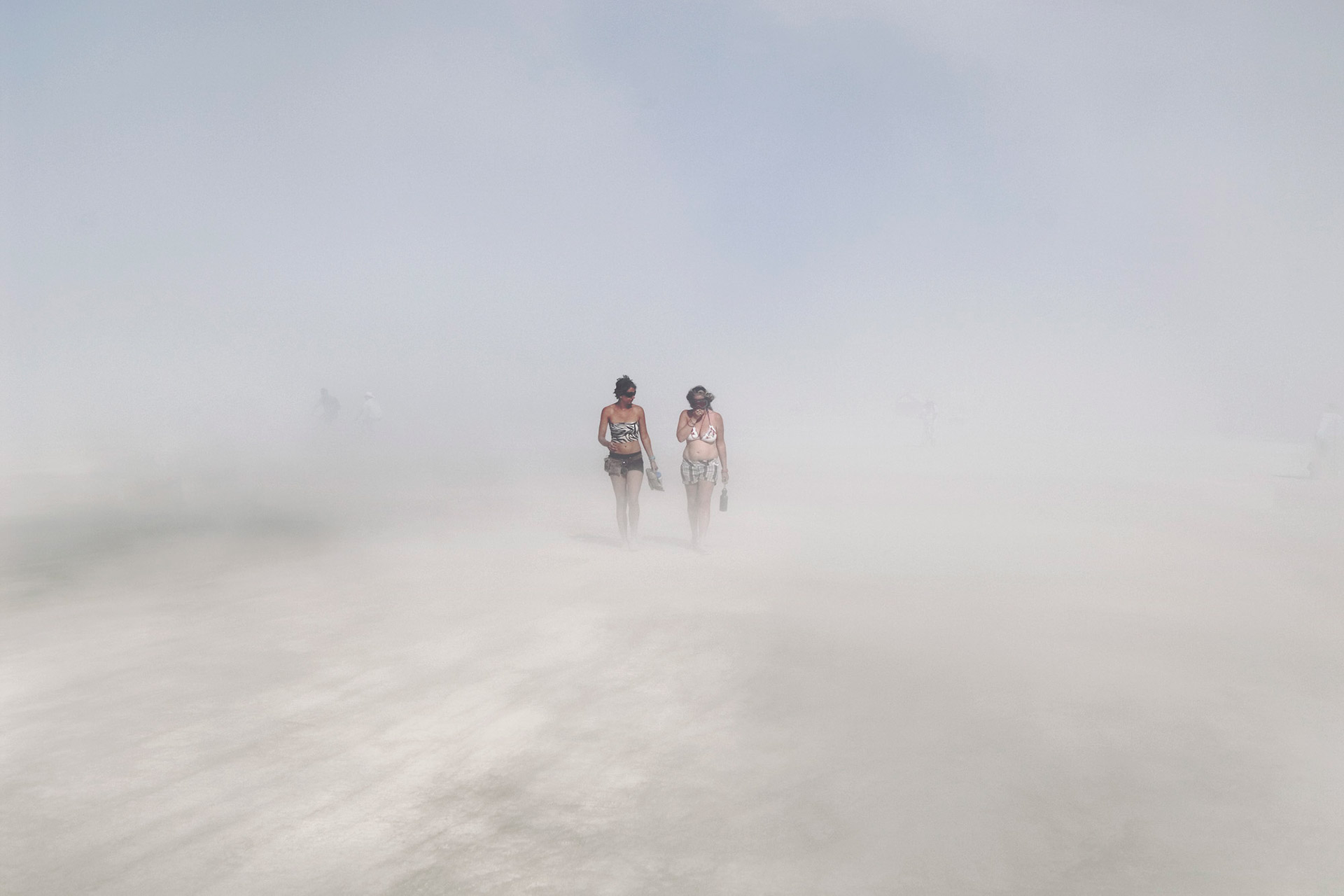
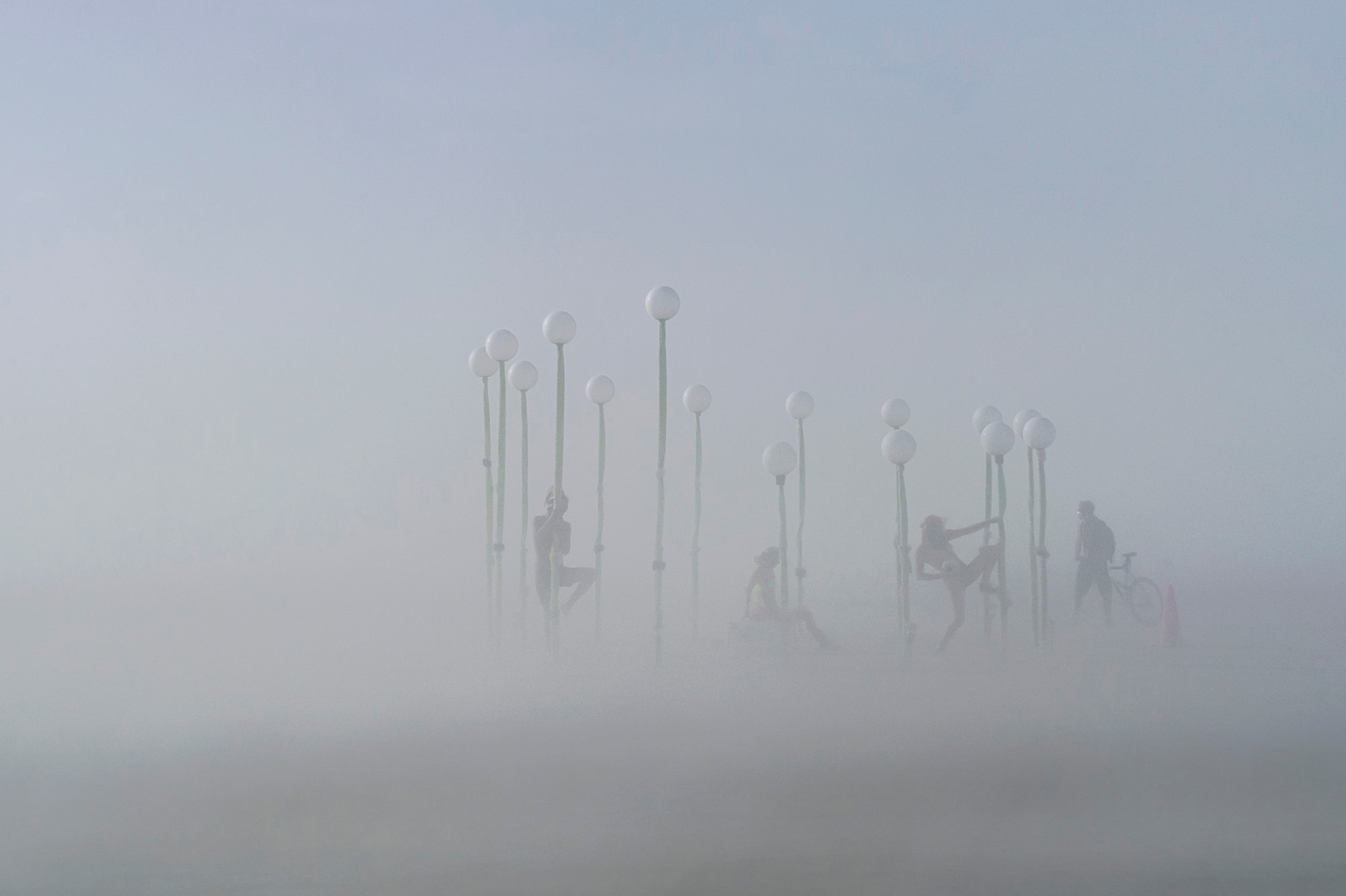
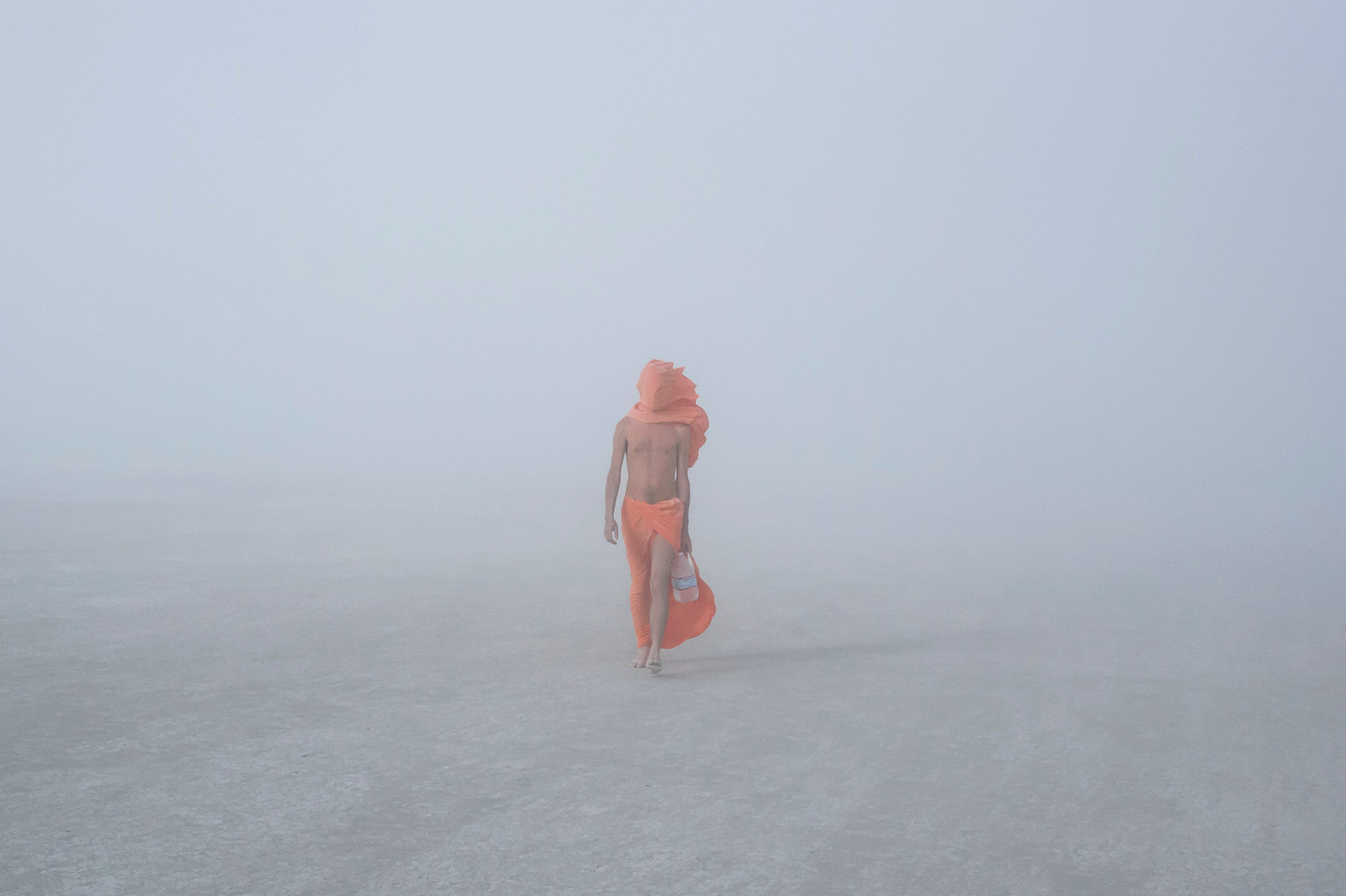
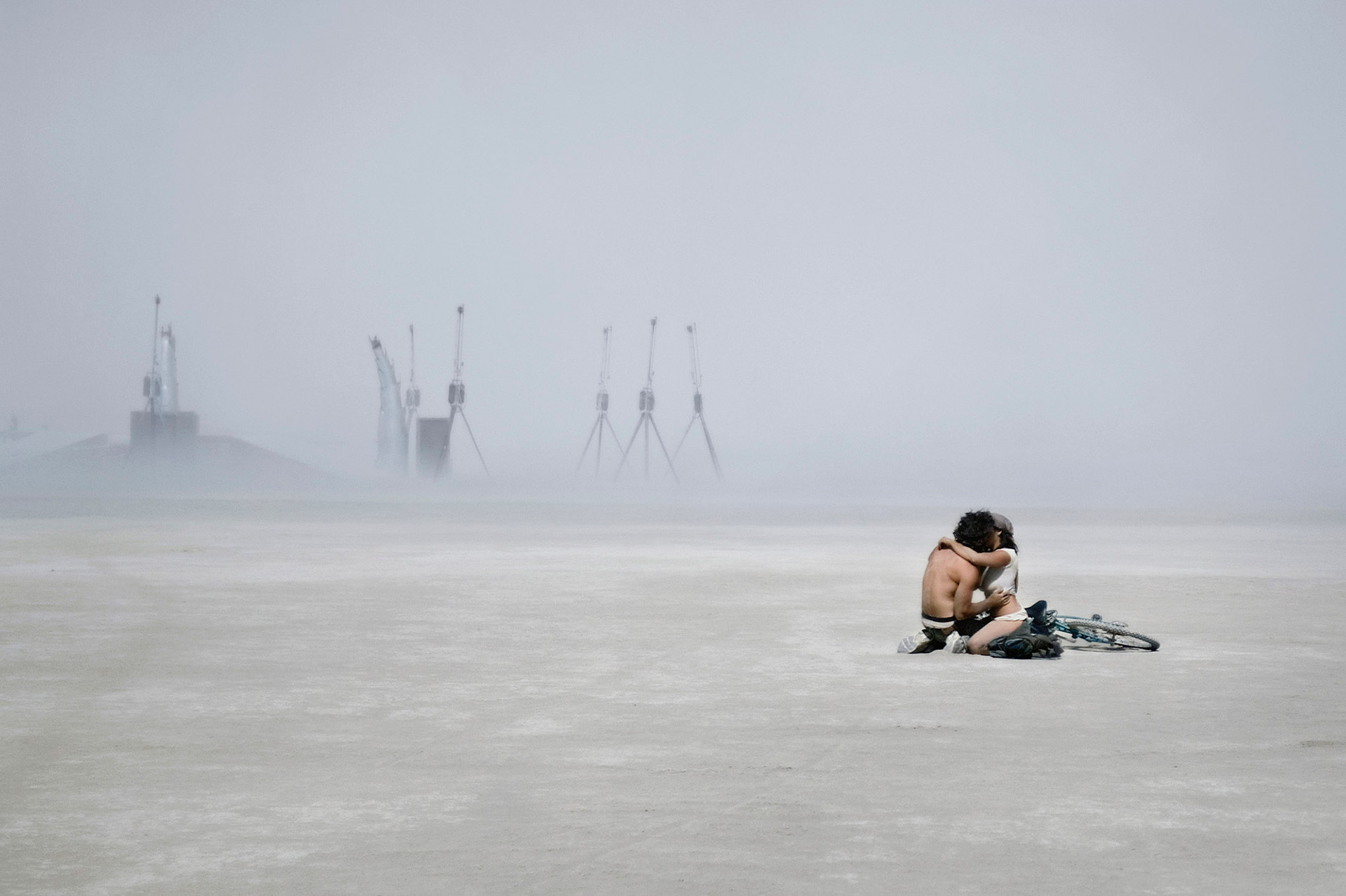
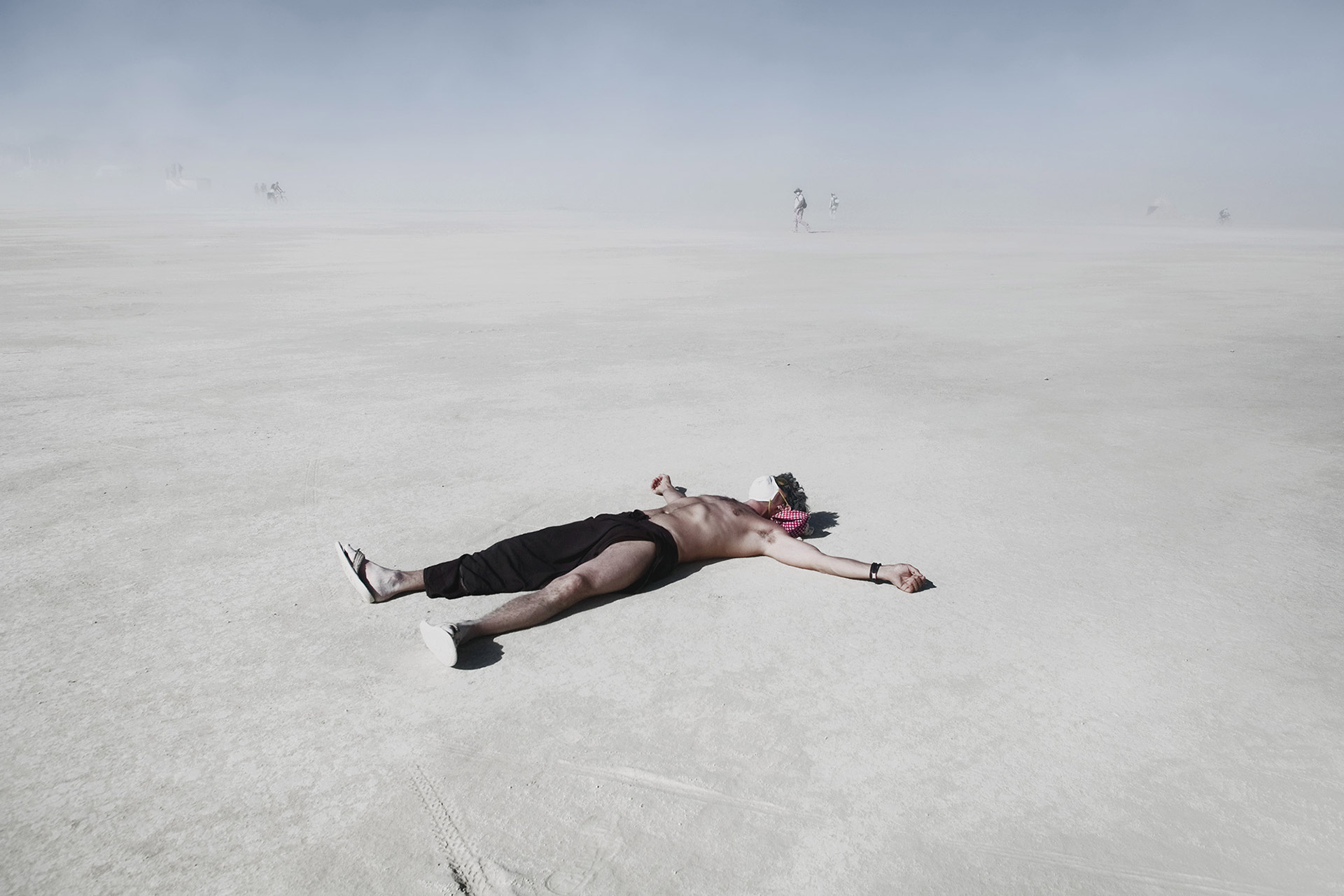
 Dina Litovsky (Ukraine, 1980). Dina Litovsky’s work examines social performances and group interactions in both public and private spaces. Dina was born in Ukraine and moved to New York in 1991. After receiving her bachelor degree in Psychology from NYU, Dina turned to photography and earned her MFA graduate degree in Photography from the School of Visual Arts, NY in 2010.
Dina Litovsky (Ukraine, 1980). Dina Litovsky’s work examines social performances and group interactions in both public and private spaces. Dina was born in Ukraine and moved to New York in 1991. After receiving her bachelor degree in Psychology from NYU, Dina turned to photography and earned her MFA graduate degree in Photography from the School of Visual Arts, NY in 2010.

The barren emptiness of the desert is devoid of sentiment. There is no poetry in the dried up surface, no melancholy stirred up by the gusts of fine sand. On a beach or in a forest, in a green field or in an architectural wonder of a city, one is overwhelmed by the beauty of the environment, the lyricism of associations and memories. But in the sudden vacuum of a desert whiteout there is only isolation.
As the sun is blocked out by the dust and the horizon is swept away, the first anxious moment of helplessness metamorphoses into a feeling of unbounded freedom. In this vast, disorienting silence, one is left entirely to the immediacy of the experience.
It is rare to find a space lacking the external noise of over-stimulation. But it is necessary in order to hear oneself better. The isolation of the whiteout brings introspection and resets the senses. The sterility of the desert becomes an oasis.














 Dina Litovsky (Ukraine, 1980). Dina Litovsky’s work examines social performances and group interactions in both public and private spaces. Dina was born in Ukraine and moved to New York in 1991. After receiving her bachelor degree in Psychology from NYU, Dina turned to photography and earned her MFA graduate degree in Photography from the School of Visual Arts, NY in 2010.
Dina Litovsky (Ukraine, 1980). Dina Litovsky’s work examines social performances and group interactions in both public and private spaces. Dina was born in Ukraine and moved to New York in 1991. After receiving her bachelor degree in Psychology from NYU, Dina turned to photography and earned her MFA graduate degree in Photography from the School of Visual Arts, NY in 2010.ZoneZero

Considered a visual artist, interactive narrator and Internet anthropologist, Harris is interested in the fragments and feelings of intimate stories, and our need to express ourselves. He converses with the viewer through images and technology, interconnected them to his own artistic universe.
In his essay Navigating Stuckness, which consists of texts and illustrations, Harris shares an autobiographical journey, describing the successive stages of his development as a creator and how he has forced himself to surpass and rediscover himself. ZoneZero has chosen two projects from these various stages, to present a sample of the enormous variety and diversity of his platforms of expression, as a glimpse of his versatile artwork.
The first is Today, photographs documenting the 440 days that followed Harris’s 30th birthday, defining a self-portrait of his everyday life and transforming this process into a ritual. In the second, Balloons of Buthan, he presents portraits of happiness in the last Himalayan kingdom, Bhutan. He uses photographs and audio testimonials to address universal concerns, and records action through an interactive platform in which we can approach each of the 117 persons he met.
These are only two examples, showing two principal lines of Harris’s artistic activity. One of these is realizing that in order to approach other people and depend on them, we must pause to know and speak about ourselves. The other line is interpreting how we can converge with technology as the best means of telling stories, thus creating platforms that give order to human chaos in our globalized, Internet-centered world.
Harris is perhaps one of the most sensitive artists present online, whose projects can inspire us to continue our own pursuit of visual communication. The ZoneZero team therefore presents an interview with him, to provide an insight into the processes involved in his work.
 Jonathan Harris (USA, 1979). Lives and works in New York, though he undertakes some of his projects in others parts of the world. Balloons of Buthan, for example, was produced in Buthan, Himalaya. An artist and computer scientist, his work explores the relationship between humans and technology. He graduated in Computer Science and Photography from Princeton University. His artwork has been exhibited throughout the world and has earned several prizes and awards. It can be viewed at: Number27
Jonathan Harris (USA, 1979). Lives and works in New York, though he undertakes some of his projects in others parts of the world. Balloons of Buthan, for example, was produced in Buthan, Himalaya. An artist and computer scientist, his work explores the relationship between humans and technology. He graduated in Computer Science and Photography from Princeton University. His artwork has been exhibited throughout the world and has earned several prizes and awards. It can be viewed at: Number27Regarding the development of your projects, could you tell us what's the place of the concept and what role does your selected media play?
For me, projects tend to start with a concept — usually something simple and communicable in a single sentence (e.g. “A search engine for feelings” (We Feel Fine), “A public library of human experience” (Cowbird), “An expression of single moments in time” (10x10). From there, I spend a lot of time developing the idea on paper (in my sketchbook). This process is iterative, and can take a long time. I’ll usually try a lot of different angles and approaches, and many of them won’t feel right, so I’ll keep trying different things, all the while keeping in mind that single-sentence description, which is like the soul of the idea, and that soul should never change. At some point, I’ll decide on an angle (e.g. search for the phrase “I feel”; constrain stories to text and a single image; scrape news websites every hour for 100 words and pictures; etc.), and will start collecting data. Then, there's the process of developing a relationship with that data, which is almost like learning the ways of a lover — to try to understand its secrets (i.e. what about it is beautiful and interesting). Once you learn its secrets, then you can design interfaces that reveal those secrets to others. That is what makes something feel poetic, and what makes it come alive.
On your most recent work, what are the topics or concerns that move you to start and develop a new project?
Currently, I’m interested in the evolution of the human species into a single meta-organism, in which we all take part, like cells in a body. I’m interested in the nature of that meta-organism — its emotions, its thoughts, its desires, its choices.
With the constant changes on technology and projects that rely so much on it, do you worry about obsolescence? How do you deal with that risk?
Working with technology, obsolescence is unavoidable. Already, some of my earlier projects are difficult or impossible to see — most browsers no longer support Java applets by default, so to view We Feel Fine, visitors must download and install a plugin; the company whose news API powered Universe was acquired and no longer exists, so that project is sadly offline. Nowadays, I try to use open source technologies (HTML5, Javascript, WebGL, etc.), which are less likely to become obsolete than proprietary technologies like Java and Flash.
On an aesthetic level, obsolescence is also a danger, but this kind of obsolescence is related to the homogenizing effect of popular tools. For instance, when many people use a tool like Adobe Illustrator, Adobe Flash, or even a service like Instagram, the shortcuts enabled by the tool will, over time, have a homogenizing effect on the projects that people use the tool to create. Because of this, many digital projects quickly look dated — they are timely, but not timeless. To avoid this, I try to design all my interfaces from scratch, not relying on shortcuts enabled by tools, but generated programmatically by code I write myself. So, for example, the typography in The Whale Hunt is custom-designed to be bisected by whaling harpoons. In Universe, all the typography is formed by star constellations. When you write stuff from scratch (using open source tools), you have a better chance at avoiding obsolescence.
You can learn more about Harris's concerns and obsessions by visiting number27.org

Considered a visual artist, interactive narrator and Internet anthropologist, Harris is interested in the fragments and feelings of intimate stories, and our need to express ourselves. He converses with the viewer through images and technology, interconnected them to his own artistic universe.
In his essay Navigating Stuckness, which consists of texts and illustrations, Harris shares an autobiographical journey, describing the successive stages of his development as a creator and how he has forced himself to surpass and rediscover himself. ZoneZero has chosen two projects from these various stages, to present a sample of the enormous variety and diversity of his platforms of expression, as a glimpse of his versatile artwork.
The first is Today, photographs documenting the 440 days that followed Harris’s 30th birthday, defining a self-portrait of his everyday life and transforming this process into a ritual. In the second, Balloons of Buthan, he presents portraits of happiness in the last Himalayan kingdom, Bhutan. He uses photographs and audio testimonials to address universal concerns, and records action through an interactive platform in which we can approach each of the 117 persons he met.
These are only two examples, showing two principal lines of Harris’s artistic activity. One of these is realizing that in order to approach other people and depend on them, we must pause to know and speak about ourselves. The other line is interpreting how we can converge with technology as the best means of telling stories, thus creating platforms that give order to human chaos in our globalized, Internet-centered world.
Harris is perhaps one of the most sensitive artists present online, whose projects can inspire us to continue our own pursuit of visual communication. The ZoneZero team therefore presents an interview with him, to provide an insight into the processes involved in his work.
 Jonathan Harris (USA, 1979). Lives and works in New York, though he undertakes some of his projects in others parts of the world. Balloons of Buthan, for example, was produced in Buthan, Himalaya. An artist and computer scientist, his work explores the relationship between humans and technology. He graduated in Computer Science and Photography from Princeton University. His artwork has been exhibited throughout the world and has earned several prizes and awards. It can be viewed at: Number27
Jonathan Harris (USA, 1979). Lives and works in New York, though he undertakes some of his projects in others parts of the world. Balloons of Buthan, for example, was produced in Buthan, Himalaya. An artist and computer scientist, his work explores the relationship between humans and technology. He graduated in Computer Science and Photography from Princeton University. His artwork has been exhibited throughout the world and has earned several prizes and awards. It can be viewed at: Number27Regarding the development of your projects, could you tell us what's the place of the concept and what role does your selected media play?
For me, projects tend to start with a concept — usually something simple and communicable in a single sentence (e.g. “A search engine for feelings” (We Feel Fine), “A public library of human experience” (Cowbird), “An expression of single moments in time” (10x10). From there, I spend a lot of time developing the idea on paper (in my sketchbook). This process is iterative, and can take a long time. I’ll usually try a lot of different angles and approaches, and many of them won’t feel right, so I’ll keep trying different things, all the while keeping in mind that single-sentence description, which is like the soul of the idea, and that soul should never change. At some point, I’ll decide on an angle (e.g. search for the phrase “I feel”; constrain stories to text and a single image; scrape news websites every hour for 100 words and pictures; etc.), and will start collecting data. Then, there's the process of developing a relationship with that data, which is almost like learning the ways of a lover — to try to understand its secrets (i.e. what about it is beautiful and interesting). Once you learn its secrets, then you can design interfaces that reveal those secrets to others. That is what makes something feel poetic, and what makes it come alive.
On your most recent work, what are the topics or concerns that move you to start and develop a new project?
Currently, I’m interested in the evolution of the human species into a single meta-organism, in which we all take part, like cells in a body. I’m interested in the nature of that meta-organism — its emotions, its thoughts, its desires, its choices.
With the constant changes on technology and projects that rely so much on it, do you worry about obsolescence? How do you deal with that risk?
Working with technology, obsolescence is unavoidable. Already, some of my earlier projects are difficult or impossible to see — most browsers no longer support Java applets by default, so to view We Feel Fine, visitors must download and install a plugin; the company whose news API powered Universe was acquired and no longer exists, so that project is sadly offline. Nowadays, I try to use open source technologies (HTML5, Javascript, WebGL, etc.), which are less likely to become obsolete than proprietary technologies like Java and Flash.
On an aesthetic level, obsolescence is also a danger, but this kind of obsolescence is related to the homogenizing effect of popular tools. For instance, when many people use a tool like Adobe Illustrator, Adobe Flash, or even a service like Instagram, the shortcuts enabled by the tool will, over time, have a homogenizing effect on the projects that people use the tool to create. Because of this, many digital projects quickly look dated — they are timely, but not timeless. To avoid this, I try to design all my interfaces from scratch, not relying on shortcuts enabled by tools, but generated programmatically by code I write myself. So, for example, the typography in The Whale Hunt is custom-designed to be bisected by whaling harpoons. In Universe, all the typography is formed by star constellations. When you write stuff from scratch (using open source tools), you have a better chance at avoiding obsolescence.
You can learn more about Harris's concerns and obsessions by visiting number27.org
Valentina Vannicola

# 01
Canto III, Ante-Inferno
The Gates of Hell
Through me the way to the city of woe,
Through me the way to eternal pain,
Through me the way among the lost.
vv. 1-3

# 02
Canto III, Ante-Inferno
Slothful
… ‘This miserable state is borne
by the wretched souls of those who lived
without disgrace yet without praise.’
vv. 34-36

# 03
Canto III, Ante-Inferno
Crossing of the Acheron
‘all those who die in the wrath of God
assemble here from every land.
And they are eager to cross the river,
for the justice of God so spurs them on
their very fear is turned to longing.’
vv. 122-126

# 04
Canto IV, Circle I
Limbo
Thus he went first and had me enter
the first circle girding the abyss.
Here, as far as I could tell by listening,
was no lamentation other than the sighs
that kept the air forever trembling.
These came from grief without torment.
vv. 23-28

# 05
Canto V, Circle II
Lustful
As doves, summoned by desire, their wings
outstretched and motionless, move on the air,
borne by their will to the sweet nest
vv. 82-84

# 06
Canto VI, Circle III
Gluttonous
The rain makes them howl like dogs
The unholy wretches often turn their bodies,
making of one side a shield for the other.
vv. 19-21

# 07
Canto VII, Circle IV
Avaricious
Here the sinners were more numerous than
elsewhere,
and they, with great shouts, from opposite sides
were shoving burdens forward with their chests.
vv. 25-27

# 08
Canto VII, Circle V
Wrathful and Sullen
And I, my gaze transfixed, could see
people with angry faces in that bog,
naked, their bodies smeared with mud.
vv. 109-111

# 09
Canto IX, Circle VI
Heretics
And he: ‘Here, with all their followers,
are the arch-heretics of every sect.
The tombs are far more laden than you think…’
vv. 127-129

# 10
Canto X, Circle VI
Farinata degli Umberti, Heretics
Already I had fixed my gaze on his.
And he was rising, lifting chest and brow
as though he held all Hell in utter scorn.
vv. 34-36

# 11
Canto XIII, Circle VII, Ring II
Suicides
We will come to claim our cast-off bodies
like the others. But it would not be just if we again
put on the flesh we robbed from our own souls.
Here shall we drag it, and in this dismal wood
our bodies will be hung, each one
upon the thorn-bush of its painful shade.
vv. 103-108

# 12
Canto XVIII, Circle VIII, Bolgia II
Flatterers, Thaïs
And then my leader said to me: ‘Try to thrust
your face a little farther forward,
to get a better picture of the features
of that foul, dishevelled wench down there,
scratching herself with her filthy nails.
Now she squats and now she’s standing up…’
vv. 127-132

# 13
Canto XIX, Circle VIII, Bolgia III
Simoniacs
From the mouth of each stuck out
a sinner’s feet and legs up to the thighs
while all the rest stayed in the hole.
vv. 22-24

# 14
Canto XXIX, Circle VIII, Bolgia X
Counterfeiters
Some lay upon the bellies or the backs
of others, still others dragged themselves
on hands and knees along that gloomy path.
Step by step we went ahead in silence,
looking and listening to the stricken spirits,
who could not raise their bodies from the ground.
vv. 67-72

# 15
Canto XXX, Circle VIII, Bolgia X
Counterfeiters, Master Adam
he said, ‘behold and then consider
the suffering of Master Adam.
Alive, I had in plenty all I wanted.
And now I crave a single drop of water!’
vv. 60-63

Inferno is a set of surrealistic scenes recreating Dante’s journey through the strata of hell. The protagonists, who represent some passages of the poem, are inhabitants of the photographer’s town, Tolfa. Italy. April 2010 - March 2011
ZZ. In which way media like cinema, theatre and literature have had an effect on your photographic projects
VV. The university studies I undertook before my photographic studies concentrated on the cinematographic art, and were within a humanities faculty where theatre and literature were certainly very present subjects. As well as this academic aspect, the experiences I had autonomously and often by chance also nourished my interests in these worlds. I don’t know the exact point these interact with my projects – certainly at the base of my work there is a strong narrative need where it is difficult for me to consider the individual shot in isolation from the whole. In most cases, I develop my story in a particular geographical area, then there is the study of this area and the involvement if its inhabitants, then, I move onto the staging. If I work on a literary text, whether it is Don Quixote or Dante’s Inferno, I start from an in-depth analysis of the text, arriving then at its schematisation, then to its re-composition according to my narrative intent and finally, the creation of a storyboard. I started to use this purely cinematographic technique not for an intellectual reason but for a question of practicality, putting into practice and adopting in my planning phase this previously studied method that very much facilitates my construction of the narration.
ZZ. In your Inferno series you staged images with non-professional actors from your hometown, what were you looking to trigger and what results did you get?
VV. As I mentioned, in all the projects I have undertaken until now, I have worked on a particular geographical area, with the involvement of its inhabitants for the staging of the stories and often for the planning. I started out with little “experiments” in my hometown – of which Dante’s Inferno represents perhaps a more aware phase – then concentrating on attempting to take this experiment outside my territorial borders. So followed Living Layers, a project on a Roman neighbourhood, born in collaboration with the Wunderkammern Gallery and Rome’s MACRO (Museum of Contemporary Art of Rome), and Riviere, which I just completed for the Bellaria Film Festival, in the Emilia Romagna region of Italy. In my research, I try to deepen my study of the areas where I am working and particularly, to seek out collaborations with the people who live there, not just for interpreting characters in the story but also for the construction of the story, whether on a practical or narrative level.
Dante’s Inferno is from 2011 and it came after other projects where I worked in my native Tolfa, a small town north of Rome. It is a more mature project compared with those that came before, both for my work on the literary text and on its inhabitants. The study and planning phase took a long time – the study and the decomposition of a text of such poetic intellect required a lot of patience, as did constructing and bringing to conclusion the 15 shots that comprise the work, which took a year. During this time, the project became rooted in the population and in the end the result was a kind of unison. The town was active on a number of fronts, from finding materials and garments for the scenes, to the involvement of other extras and suggesting locations they had seen during their days working in the fields. It is a project that very much fed my interest in this type of research, which I continue to take forward in its variations.
ZZ. How has this experience influenced your current interests?
VV. This type of experience repeats itself in different ways in almost all of my work. Looking for an interaction with a place and its inhabitants is the point I seek keep constant in my stories. Just a few weeks ago, I finished new work on an area that I had never visited before then – the Romagnola Riviera, on the coast of the Emilia Romagna region. During the summer time, it transforms into an hive of tourists, with hundreds of geometrically placed and chaotically crowded beach umbrellas, boat trips, bocce matches, lunches at the pensione, and theme parks – a very noisy world which, during the winter, suddenly disappears and makes way for something even more surreal, and my arrival happened exactly at that moment: the Romagnola Riviera in winter, a great sleeping city where everything is suspended on the edge of waiting; the Riviera in the off season: pastel coloured rows of closed hotels and pensiones, enormous plastic play and games equipment and palm trees wrapped in transparent towelling on the beach, everything protected in sleep. More than the taste of waiting, every element seemed to recall something that had been infinite before, in a timeless age. In this temporal suspension, retired fishermen, dancers from the dance hall of the centre for the elderly, new friends and hoteliers ferried me through this new story, entitled Riviere. The story begins from an investigation into facts that actually occurred in the 1960s – the construction of an island in the neighbouring Adriatic waters and its bombing by the Italian state – events that weave in with the story of my grandparents and their photographic archive from 1990 to 2000, and finishes with my arrival at Rimini station in January 2014.
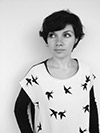 Valentina Vannicola (Italy, 1982). Lives and works in Italy. After a degree in Film Studies at the Sapienza University of Rome, she went on to a diploma in photography at the Scuola Romana di Fotografia. Her images are strongly influenced by cinema, theatre and literature. Her work, for which she has received several awards, has been exhibited in France, Australia, Austria and Italy. She is represented by OnOff Picture Photo Agency and by the Wunderkammern Gallery.
Valentina Vannicola (Italy, 1982). Lives and works in Italy. After a degree in Film Studies at the Sapienza University of Rome, she went on to a diploma in photography at the Scuola Romana di Fotografia. Her images are strongly influenced by cinema, theatre and literature. Her work, for which she has received several awards, has been exhibited in France, Australia, Austria and Italy. She is represented by OnOff Picture Photo Agency and by the Wunderkammern Gallery.
# 01
Canto III, Ante-Inferno
The Gates of Hell
Through me the way to the city of woe,
Through me the way to eternal pain,
Through me the way among the lost.
vv. 1-3

# 02
Canto III, Ante-Inferno
Slothful
… ‘This miserable state is borne
by the wretched souls of those who lived
without disgrace yet without praise.’
vv. 34-36

# 03
Canto III, Ante-Inferno
Crossing of the Acheron
‘all those who die in the wrath of God
assemble here from every land.
And they are eager to cross the river,
for the justice of God so spurs them on
their very fear is turned to longing.’
vv. 122-126

# 04
Canto IV, Circle I
Limbo
Thus he went first and had me enter
the first circle girding the abyss.
Here, as far as I could tell by listening,
was no lamentation other than the sighs
that kept the air forever trembling.
These came from grief without torment.
vv. 23-28

# 05
Canto V, Circle II
Lustful
As doves, summoned by desire, their wings
outstretched and motionless, move on the air,
borne by their will to the sweet nest
vv. 82-84

# 06
Canto VI, Circle III
Gluttonous
The rain makes them howl like dogs
The unholy wretches often turn their bodies,
making of one side a shield for the other.
vv. 19-21

# 07
Canto VII, Circle IV
Avaricious
Here the sinners were more numerous than
elsewhere,
and they, with great shouts, from opposite sides
were shoving burdens forward with their chests.
vv. 25-27

# 08
Canto VII, Circle V
Wrathful and Sullen
And I, my gaze transfixed, could see
people with angry faces in that bog,
naked, their bodies smeared with mud.
vv. 109-111

# 09
Canto IX, Circle VI
Heretics
And he: ‘Here, with all their followers,
are the arch-heretics of every sect.
The tombs are far more laden than you think…’
vv. 127-129

# 10
Canto X, Circle VI
Farinata degli Umberti, Heretics
Already I had fixed my gaze on his.
And he was rising, lifting chest and brow
as though he held all Hell in utter scorn.
vv. 34-36

# 11
Canto XIII, Circle VII, Ring II
Suicides
We will come to claim our cast-off bodies
like the others. But it would not be just if we again
put on the flesh we robbed from our own souls.
Here shall we drag it, and in this dismal wood
our bodies will be hung, each one
upon the thorn-bush of its painful shade.
vv. 103-108

# 12
Canto XVIII, Circle VIII, Bolgia II
Flatterers, Thaïs
And then my leader said to me: ‘Try to thrust
your face a little farther forward,
to get a better picture of the features
of that foul, dishevelled wench down there,
scratching herself with her filthy nails.
Now she squats and now she’s standing up…’
vv. 127-132

# 13
Canto XIX, Circle VIII, Bolgia III
Simoniacs
From the mouth of each stuck out
a sinner’s feet and legs up to the thighs
while all the rest stayed in the hole.
vv. 22-24

# 14
Canto XXIX, Circle VIII, Bolgia X
Counterfeiters
Some lay upon the bellies or the backs
of others, still others dragged themselves
on hands and knees along that gloomy path.
Step by step we went ahead in silence,
looking and listening to the stricken spirits,
who could not raise their bodies from the ground.
vv. 67-72

# 15
Canto XXX, Circle VIII, Bolgia X
Counterfeiters, Master Adam
he said, ‘behold and then consider
the suffering of Master Adam.
Alive, I had in plenty all I wanted.
And now I crave a single drop of water!’
vv. 60-63

Inferno is a set of surrealistic scenes recreating Dante’s journey through the strata of hell. The protagonists, who represent some passages of the poem, are inhabitants of the photographer’s town, Tolfa. Italy. April 2010 - March 2011
ZZ. In which way media like cinema, theatre and literature have had an effect on your photographic projects
VV. The university studies I undertook before my photographic studies concentrated on the cinematographic art, and were within a humanities faculty where theatre and literature were certainly very present subjects. As well as this academic aspect, the experiences I had autonomously and often by chance also nourished my interests in these worlds. I don’t know the exact point these interact with my projects – certainly at the base of my work there is a strong narrative need where it is difficult for me to consider the individual shot in isolation from the whole. In most cases, I develop my story in a particular geographical area, then there is the study of this area and the involvement if its inhabitants, then, I move onto the staging. If I work on a literary text, whether it is Don Quixote or Dante’s Inferno, I start from an in-depth analysis of the text, arriving then at its schematisation, then to its re-composition according to my narrative intent and finally, the creation of a storyboard. I started to use this purely cinematographic technique not for an intellectual reason but for a question of practicality, putting into practice and adopting in my planning phase this previously studied method that very much facilitates my construction of the narration.
ZZ. In your Inferno series you staged images with non-professional actors from your hometown, what were you looking to trigger and what results did you get?
VV. As I mentioned, in all the projects I have undertaken until now, I have worked on a particular geographical area, with the involvement of its inhabitants for the staging of the stories and often for the planning. I started out with little “experiments” in my hometown – of which Dante’s Inferno represents perhaps a more aware phase – then concentrating on attempting to take this experiment outside my territorial borders. So followed Living Layers, a project on a Roman neighbourhood, born in collaboration with the Wunderkammern Gallery and Rome’s MACRO (Museum of Contemporary Art of Rome), and Riviere, which I just completed for the Bellaria Film Festival, in the Emilia Romagna region of Italy. In my research, I try to deepen my study of the areas where I am working and particularly, to seek out collaborations with the people who live there, not just for interpreting characters in the story but also for the construction of the story, whether on a practical or narrative level.
Dante’s Inferno is from 2011 and it came after other projects where I worked in my native Tolfa, a small town north of Rome. It is a more mature project compared with those that came before, both for my work on the literary text and on its inhabitants. The study and planning phase took a long time – the study and the decomposition of a text of such poetic intellect required a lot of patience, as did constructing and bringing to conclusion the 15 shots that comprise the work, which took a year. During this time, the project became rooted in the population and in the end the result was a kind of unison. The town was active on a number of fronts, from finding materials and garments for the scenes, to the involvement of other extras and suggesting locations they had seen during their days working in the fields. It is a project that very much fed my interest in this type of research, which I continue to take forward in its variations.
ZZ. How has this experience influenced your current interests?
VV. This type of experience repeats itself in different ways in almost all of my work. Looking for an interaction with a place and its inhabitants is the point I seek keep constant in my stories. Just a few weeks ago, I finished new work on an area that I had never visited before then – the Romagnola Riviera, on the coast of the Emilia Romagna region. During the summer time, it transforms into an hive of tourists, with hundreds of geometrically placed and chaotically crowded beach umbrellas, boat trips, bocce matches, lunches at the pensione, and theme parks – a very noisy world which, during the winter, suddenly disappears and makes way for something even more surreal, and my arrival happened exactly at that moment: the Romagnola Riviera in winter, a great sleeping city where everything is suspended on the edge of waiting; the Riviera in the off season: pastel coloured rows of closed hotels and pensiones, enormous plastic play and games equipment and palm trees wrapped in transparent towelling on the beach, everything protected in sleep. More than the taste of waiting, every element seemed to recall something that had been infinite before, in a timeless age. In this temporal suspension, retired fishermen, dancers from the dance hall of the centre for the elderly, new friends and hoteliers ferried me through this new story, entitled Riviere. The story begins from an investigation into facts that actually occurred in the 1960s – the construction of an island in the neighbouring Adriatic waters and its bombing by the Italian state – events that weave in with the story of my grandparents and their photographic archive from 1990 to 2000, and finishes with my arrival at Rimini station in January 2014.
 Valentina Vannicola (Italy, 1982). Lives and works in Italy. After a degree in Film Studies at the Sapienza University of Rome, she went on to a diploma in photography at the Scuola Romana di Fotografia. Her images are strongly influenced by cinema, theatre and literature. Her work, for which she has received several awards, has been exhibited in France, Australia, Austria and Italy. She is represented by OnOff Picture Photo Agency and by the Wunderkammern Gallery.
Valentina Vannicola (Italy, 1982). Lives and works in Italy. After a degree in Film Studies at the Sapienza University of Rome, she went on to a diploma in photography at the Scuola Romana di Fotografia. Her images are strongly influenced by cinema, theatre and literature. Her work, for which she has received several awards, has been exhibited in France, Australia, Austria and Italy. She is represented by OnOff Picture Photo Agency and by the Wunderkammern Gallery.Jorge Panchoaga


La Casa Grande is a work that reflects on an indigenous family living in Cauca. It approaches territory as a social setting essential for constructing a cultural identity and simultaneously surviving in time despite armed conflict, stigmatization and the modern pace of life the country seeks to achieve. Identity has become an important issue in recent years, and social individualization is rooted in the understanding of this social aspect: replacing the individual’s group condition with a civil one. This work highlights the importance of union in surviving and resisting time, and reflect son the great pillars of the construction of indigenous identity: community, home, family, cultural heritage and the need for a territory to inhabit. Ambaló, the place where these pictures were taken, appears a peaceful land, which all of us who live in Colombia wish for. These surroundings contrast with the image we have of Cauca, as one of the provinces most severely affected by armed conflict and forced displacement. The images in this work lead us to imagine intimate spaces suggesting the value of these stories experienced at home, a space that has been snatched from many Cauca residents. Light is used to reveal other possible worlds, using the darkroom created in each of the houses. Each image transforms the daily outside space, enabling us to visualize Cauca and a country of peace and abundance, using our capacity to imagine a more magical world, where respect for life reigns.























“He linked his life to the bitterness
of those whose only roof is the firmament,
whose only milk is the hard soil,
and whose only pillow is their sad thoughts.”
Ninfa Aracely Manzano,
Beyond my sadness, Popayán, 2009
The province of Cauca has historically been socially and geographically important to Colombia. Firstly, as an indigenous enclave in which communities such as the Pishau, Nasa Coconuco, Misak coexist, linked by trade and interethnic policies. This region was already inhabited when the Spaniards arrived. In 1537, Ampudia and Añasco fought the indigenous groups led by the Cacique Payan y Calambas, in a 30-day struggle in which the former’s superior weapons enabled them to defeat the caciques. After the war, showing that struggle was not the only means of resistance, there was a severe famine, during which there was nothing to eat for months. “In a suicidal act of resistance, they then decided to refuse to sow and harvest, thereby hoping to expel the invaders from their territory”, wrote the chronicler Andagoya. Colonial social life was marked by the subordination and exploitation of the indigenous population, as a reward for the campaign to conquer them. Subsequently, during the fight for independence and the construction of the nation-State, the Cauca contributed soldiers to the struggle. In that context, there was clearly a secular relationship between the individual, his assets and his heritage. The land was the homeland, the physical embodiment of the nation, designed to replace the local with the national and its identity, ignoring singular, varied stories in favor of a unique national history.
The 1821 map issued by the Popayán council members to the new center of power: Bogotá, reproduced the relations of social, political and economic subordination that characterized indigenous social life in the colony . The Republican laws sought to favor the hacienda system rather than providing protection, thereby obtaining free labor from the indigenous populations. Thus independence did not truly change conditions, however the indigenous people resisted through their traditions and way of life. In 1991, the country’s cultural diversity was recognized, yet for decades the territory has been mired in a war which it has proved impossible to end. In 2012, several reports indicated that the province of Cauca was a social setting in which the most families were forcibly displaced . In total it is estimated that over 700,000 persons abandoned their belongings and living space for various reasons, mainly armed conflict. There has been resistance in all these contexts, not always as a strictly political event or act of protest but also as an everyday act in which heritage, family stories and community life prevail. Indeed, resistance is sown in Casa Grande, in the form of territory.
Every human being has a piece of sky to gaze at, intimately linked to the territory in which he was born to live with his family, and to his window, and what he inherited from the elders to link the construction of an identity to the earth and his fellow men, thereby constructing a vision of the world. Home, as the first social setting, is a means of consolidating the basic social nucleus of any community. There, cultural differences are established, stories and myths are transmitted to identify the person, and the universe is constructed in every society. Consequently, difference unites us in the home and family, as we inherit all our forefathers’ knowledge, living in similar spaces, sleeping in different but similar interiors, and using tools to survive and relate to our environment. In the home, we are all a fundamental part of a cosmic and vital world, and at the same time a world that expects us to construct a dialectic of life.
The dark rooms1 have been built with the families and friends that we have made in the course of this project. Entering the territory, each interior and space in the home, is and represents this historical, identity process whereby family, culture and territory are linked in an unfathomable unity, impossible to defragment. The kitchen as the best place for handing down the knowledge of the elders. The bedroom as a setting for dreaming of possible worlds. Walls on which to hang the memories that indicate our social evolution. At the same time, the inverted images remind us that it is possible to transform our reality.
The portrait subjects are objects and persons. These brought me into contact with everyday life and historical symbols, and at the same time, enabled me to understand their way of life and each character’s personality. Many portraits in this series are anonymous, not because they do not have a name but because they celebrate the value of union, and create the possibility of being each of us. Finally, the homes have been lit with each family's lanterns, and the photos have been sealed by family members, as I painted the house with the light of their torches. This exercise taught us that it is crucial to imagine and build together.
The images displayed here are based on this construction of friendships and my curiosity to learn about the historical indigenous resistance. These are a joint work, to depict daily life and carry out a task not common in photography: imagining new potential realities, a crucial dynamic in the epistemic philosophy of constructing new worlds, in which the home and tranquility of the Cauca and Colombian family are possible.
1 The darkroom is an optical tool that allows a flat projection of an external image to be projected on the inside of its surface. It is one of several ancient procedures that led to the development of photography. Today’s photographic devices inherited the word camera from the ancient dark rooms. It consists of a closed box with a small hole through which a small quantity of light enters and projects the image of the exterior onto the opposite wall. The hole serves as a convergent lens and projects an image of the exterior, inverted both vertically and horizontally.
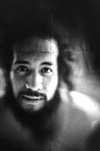 Jorge Panchoaga (Colombia, 1984). Lives and works in Colombia. He teaches the specialization in Photography at the Arts Faculty of the Universidad Nacional de Colombia. As a photographer, his interests focus on socio-cultural issues of identity, memory, language, cultural change following conflict and man’s relationship with the landscape. He graduated in Anthropology from the Universidad de Cauca. He is a photography specialist at the Universidad Nacional de Colombia. He is an X-photographer at Fujifilm Colombia, and belongs to the +1 Photography Collective. His work is available at: jorgepanchoaga.com/
Jorge Panchoaga (Colombia, 1984). Lives and works in Colombia. He teaches the specialization in Photography at the Arts Faculty of the Universidad Nacional de Colombia. As a photographer, his interests focus on socio-cultural issues of identity, memory, language, cultural change following conflict and man’s relationship with the landscape. He graduated in Anthropology from the Universidad de Cauca. He is a photography specialist at the Universidad Nacional de Colombia. He is an X-photographer at Fujifilm Colombia, and belongs to the +1 Photography Collective. His work is available at: jorgepanchoaga.com/

La Casa Grande is a work that reflects on an indigenous family living in Cauca. It approaches territory as a social setting essential for constructing a cultural identity and simultaneously surviving in time despite armed conflict, stigmatization and the modern pace of life the country seeks to achieve. Identity has become an important issue in recent years, and social individualization is rooted in the understanding of this social aspect: replacing the individual’s group condition with a civil one. This work highlights the importance of union in surviving and resisting time, and reflect son the great pillars of the construction of indigenous identity: community, home, family, cultural heritage and the need for a territory to inhabit. Ambaló, the place where these pictures were taken, appears a peaceful land, which all of us who live in Colombia wish for. These surroundings contrast with the image we have of Cauca, as one of the provinces most severely affected by armed conflict and forced displacement. The images in this work lead us to imagine intimate spaces suggesting the value of these stories experienced at home, a space that has been snatched from many Cauca residents. Light is used to reveal other possible worlds, using the darkroom created in each of the houses. Each image transforms the daily outside space, enabling us to visualize Cauca and a country of peace and abundance, using our capacity to imagine a more magical world, where respect for life reigns.























“He linked his life to the bitterness
of those whose only roof is the firmament,
whose only milk is the hard soil,
and whose only pillow is their sad thoughts.”
Ninfa Aracely Manzano,
Beyond my sadness, Popayán, 2009
The province of Cauca has historically been socially and geographically important to Colombia. Firstly, as an indigenous enclave in which communities such as the Pishau, Nasa Coconuco, Misak coexist, linked by trade and interethnic policies. This region was already inhabited when the Spaniards arrived. In 1537, Ampudia and Añasco fought the indigenous groups led by the Cacique Payan y Calambas, in a 30-day struggle in which the former’s superior weapons enabled them to defeat the caciques. After the war, showing that struggle was not the only means of resistance, there was a severe famine, during which there was nothing to eat for months. “In a suicidal act of resistance, they then decided to refuse to sow and harvest, thereby hoping to expel the invaders from their territory”, wrote the chronicler Andagoya. Colonial social life was marked by the subordination and exploitation of the indigenous population, as a reward for the campaign to conquer them. Subsequently, during the fight for independence and the construction of the nation-State, the Cauca contributed soldiers to the struggle. In that context, there was clearly a secular relationship between the individual, his assets and his heritage. The land was the homeland, the physical embodiment of the nation, designed to replace the local with the national and its identity, ignoring singular, varied stories in favor of a unique national history.
The 1821 map issued by the Popayán council members to the new center of power: Bogotá, reproduced the relations of social, political and economic subordination that characterized indigenous social life in the colony . The Republican laws sought to favor the hacienda system rather than providing protection, thereby obtaining free labor from the indigenous populations. Thus independence did not truly change conditions, however the indigenous people resisted through their traditions and way of life. In 1991, the country’s cultural diversity was recognized, yet for decades the territory has been mired in a war which it has proved impossible to end. In 2012, several reports indicated that the province of Cauca was a social setting in which the most families were forcibly displaced . In total it is estimated that over 700,000 persons abandoned their belongings and living space for various reasons, mainly armed conflict. There has been resistance in all these contexts, not always as a strictly political event or act of protest but also as an everyday act in which heritage, family stories and community life prevail. Indeed, resistance is sown in Casa Grande, in the form of territory.
Every human being has a piece of sky to gaze at, intimately linked to the territory in which he was born to live with his family, and to his window, and what he inherited from the elders to link the construction of an identity to the earth and his fellow men, thereby constructing a vision of the world. Home, as the first social setting, is a means of consolidating the basic social nucleus of any community. There, cultural differences are established, stories and myths are transmitted to identify the person, and the universe is constructed in every society. Consequently, difference unites us in the home and family, as we inherit all our forefathers’ knowledge, living in similar spaces, sleeping in different but similar interiors, and using tools to survive and relate to our environment. In the home, we are all a fundamental part of a cosmic and vital world, and at the same time a world that expects us to construct a dialectic of life.
The dark rooms1 have been built with the families and friends that we have made in the course of this project. Entering the territory, each interior and space in the home, is and represents this historical, identity process whereby family, culture and territory are linked in an unfathomable unity, impossible to defragment. The kitchen as the best place for handing down the knowledge of the elders. The bedroom as a setting for dreaming of possible worlds. Walls on which to hang the memories that indicate our social evolution. At the same time, the inverted images remind us that it is possible to transform our reality.
The portrait subjects are objects and persons. These brought me into contact with everyday life and historical symbols, and at the same time, enabled me to understand their way of life and each character’s personality. Many portraits in this series are anonymous, not because they do not have a name but because they celebrate the value of union, and create the possibility of being each of us. Finally, the homes have been lit with each family's lanterns, and the photos have been sealed by family members, as I painted the house with the light of their torches. This exercise taught us that it is crucial to imagine and build together.
The images displayed here are based on this construction of friendships and my curiosity to learn about the historical indigenous resistance. These are a joint work, to depict daily life and carry out a task not common in photography: imagining new potential realities, a crucial dynamic in the epistemic philosophy of constructing new worlds, in which the home and tranquility of the Cauca and Colombian family are possible.
1 The darkroom is an optical tool that allows a flat projection of an external image to be projected on the inside of its surface. It is one of several ancient procedures that led to the development of photography. Today’s photographic devices inherited the word camera from the ancient dark rooms. It consists of a closed box with a small hole through which a small quantity of light enters and projects the image of the exterior onto the opposite wall. The hole serves as a convergent lens and projects an image of the exterior, inverted both vertically and horizontally.
 Jorge Panchoaga (Colombia, 1984). Lives and works in Colombia. He teaches the specialization in Photography at the Arts Faculty of the Universidad Nacional de Colombia. As a photographer, his interests focus on socio-cultural issues of identity, memory, language, cultural change following conflict and man’s relationship with the landscape. He graduated in Anthropology from the Universidad de Cauca. He is a photography specialist at the Universidad Nacional de Colombia. He is an X-photographer at Fujifilm Colombia, and belongs to the +1 Photography Collective. His work is available at: jorgepanchoaga.com/
Jorge Panchoaga (Colombia, 1984). Lives and works in Colombia. He teaches the specialization in Photography at the Arts Faculty of the Universidad Nacional de Colombia. As a photographer, his interests focus on socio-cultural issues of identity, memory, language, cultural change following conflict and man’s relationship with the landscape. He graduated in Anthropology from the Universidad de Cauca. He is a photography specialist at the Universidad Nacional de Colombia. He is an X-photographer at Fujifilm Colombia, and belongs to the +1 Photography Collective. His work is available at: jorgepanchoaga.com/Svjetlana Tepavcevic
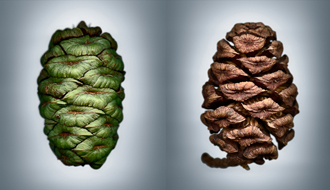

Means of Reproduction is a photography project that explores the transformative power of seeds.
I portray these microcosms as large and mysterious presences, evoking their latent energy and potential to initiate new life through their own transformation. Seeds and the vessels that shield them are essential elements of life and a testament to its enormous vitality and resilience.
The passage of time is a strong element in my images. Seeds themselves are an embodiment of the long and invisible time that continues to shape them and to encapsulate within them the code for new life. Another signifier of passing time, decay, appears frequently and symbolizes memento mori: not only is life fleeting and finite, life and death are two ends of the same continuum.
The selection of images in Means of Reproduction is personal and subjective: I depict only those seeds and seed pods I encounter in ordinary, everyday situations, often while walking. Making these images is an act of contemplation, of discovery and learning, and of love. It brings me closer to nature, whose astonishing designs I now appreciate more than ever.

















 Svjetlana Tepavcevic (Bosnia). Lives and works in Washington D.C. A photographer, she graduated in Art from the University of California and Los Angeles, then received a Masters’ Degree in Art from the Annenberg School of Communication, University of Pennsylvania. She has taken part in numerous exhibitions, both individual and collective, and has received several prizes. Tepavcevic’s work explores her environment, based on detailed and long-term observation and focusing on the relationship with objects. Her work can be viewed at Svjetlana Tepavcevic.
Svjetlana Tepavcevic (Bosnia). Lives and works in Washington D.C. A photographer, she graduated in Art from the University of California and Los Angeles, then received a Masters’ Degree in Art from the Annenberg School of Communication, University of Pennsylvania. She has taken part in numerous exhibitions, both individual and collective, and has received several prizes. Tepavcevic’s work explores her environment, based on detailed and long-term observation and focusing on the relationship with objects. Her work can be viewed at Svjetlana Tepavcevic.

Means of Reproduction is a photography project that explores the transformative power of seeds.
I portray these microcosms as large and mysterious presences, evoking their latent energy and potential to initiate new life through their own transformation. Seeds and the vessels that shield them are essential elements of life and a testament to its enormous vitality and resilience.
The passage of time is a strong element in my images. Seeds themselves are an embodiment of the long and invisible time that continues to shape them and to encapsulate within them the code for new life. Another signifier of passing time, decay, appears frequently and symbolizes memento mori: not only is life fleeting and finite, life and death are two ends of the same continuum.
The selection of images in Means of Reproduction is personal and subjective: I depict only those seeds and seed pods I encounter in ordinary, everyday situations, often while walking. Making these images is an act of contemplation, of discovery and learning, and of love. It brings me closer to nature, whose astonishing designs I now appreciate more than ever.

















 Svjetlana Tepavcevic (Bosnia). Lives and works in Washington D.C. A photographer, she graduated in Art from the University of California and Los Angeles, then received a Masters’ Degree in Art from the Annenberg School of Communication, University of Pennsylvania. She has taken part in numerous exhibitions, both individual and collective, and has received several prizes. Tepavcevic’s work explores her environment, based on detailed and long-term observation and focusing on the relationship with objects. Her work can be viewed at Svjetlana Tepavcevic.
Svjetlana Tepavcevic (Bosnia). Lives and works in Washington D.C. A photographer, she graduated in Art from the University of California and Los Angeles, then received a Masters’ Degree in Art from the Annenberg School of Communication, University of Pennsylvania. She has taken part in numerous exhibitions, both individual and collective, and has received several prizes. Tepavcevic’s work explores her environment, based on detailed and long-term observation and focusing on the relationship with objects. Her work can be viewed at Svjetlana Tepavcevic.Álvaro Sánchez-Montañés


The end of the First World War put an end to the exploitation of the Kolmannskuppe mines in the Namibia desert, which had been one of the most flourishing settlements in southern Africa for over two decades. During that time of splendor, the German settlers who administered the mines built peculiar homes reminiscent of their native Bavaria, as regards both their architectural form and decoration. The closure of the mines and departure of its inhabitants turned Kolmanskuppe into a ghost town engulfed by sand. The Indoor Desert series explores these houses abandoned in the desert, revealing the spell cast by their peaceful rooms.















 Álvaro Sánchez-Montañés (Madrid, 1973). Lives and works in Barcelona, Spain, though he produces some of his projects in others parts of the world. Indoor desert, for example, was produced in Kolmannskuppe, Germany. A photographer, he qualified as an Aeronautical Engineer at the Polytechnic University of Madrid and is self-taught in artistic disciplines. His works have been exhibited in cities such as Barcelona, Madrid, Bilbao, Seville, Mexico City, London and New York, and have received numerous prizes. They can be viewed at www.alvarosh.es
Álvaro Sánchez-Montañés (Madrid, 1973). Lives and works in Barcelona, Spain, though he produces some of his projects in others parts of the world. Indoor desert, for example, was produced in Kolmannskuppe, Germany. A photographer, he qualified as an Aeronautical Engineer at the Polytechnic University of Madrid and is self-taught in artistic disciplines. His works have been exhibited in cities such as Barcelona, Madrid, Bilbao, Seville, Mexico City, London and New York, and have received numerous prizes. They can be viewed at www.alvarosh.es

The end of the First World War put an end to the exploitation of the Kolmannskuppe mines in the Namibia desert, which had been one of the most flourishing settlements in southern Africa for over two decades. During that time of splendor, the German settlers who administered the mines built peculiar homes reminiscent of their native Bavaria, as regards both their architectural form and decoration. The closure of the mines and departure of its inhabitants turned Kolmanskuppe into a ghost town engulfed by sand. The Indoor Desert series explores these houses abandoned in the desert, revealing the spell cast by their peaceful rooms.















 Álvaro Sánchez-Montañés (Madrid, 1973). Lives and works in Barcelona, Spain, though he produces some of his projects in others parts of the world. Indoor desert, for example, was produced in Kolmannskuppe, Germany. A photographer, he qualified as an Aeronautical Engineer at the Polytechnic University of Madrid and is self-taught in artistic disciplines. His works have been exhibited in cities such as Barcelona, Madrid, Bilbao, Seville, Mexico City, London and New York, and have received numerous prizes. They can be viewed at www.alvarosh.es
Álvaro Sánchez-Montañés (Madrid, 1973). Lives and works in Barcelona, Spain, though he produces some of his projects in others parts of the world. Indoor desert, for example, was produced in Kolmannskuppe, Germany. A photographer, he qualified as an Aeronautical Engineer at the Polytechnic University of Madrid and is self-taught in artistic disciplines. His works have been exhibited in cities such as Barcelona, Madrid, Bilbao, Seville, Mexico City, London and New York, and have received numerous prizes. They can be viewed at www.alvarosh.esClement Valla


I collect Google Earth images. I discovered strange moments where the illusion of a seamless representation of the Earth’s surface seems to break down. At first, I thought they were glitches, or errors in the algorithm, but looking closer I realized the situation was actually more interesting — these images are not glitches. They are the absolute logical result of the system. They are an edge condition—an anomaly within the system, a nonstandard, an outlier, even, but not an error. These jarring moments expose how Google Earth works, focusing our attention on the software. They reveal a new model of representation: not through indexical photographs but through automated data collection from a myriad of different sources constantly updated and endlessly combined to create a seamless illusion; Google Earth is a database disguised as a photographic representation. These uncanny images focus our attention on that process itself, and the network of algorithms, computers, storage systems, automated cameras, maps, pilots, engineers, photographers, surveyors and map-makers that generate them.





















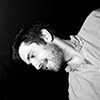 Clement Valla (USA, 1979). Lives and works in Brooklyn, New York. He received a BA in Architecture from Columbia University and a MFA from the Rhode Island School of Design in Digital+Media. He is currently an associate professor of Graphic Design at RISD. His work has been exhibited in several internationally places as The Indianapolis Museum of Art, Indianapolis; Museum of the Moving Image, New York; Thommassen Galleri, Gothenbur, etc. His work is available at clementvalla.com
Clement Valla (USA, 1979). Lives and works in Brooklyn, New York. He received a BA in Architecture from Columbia University and a MFA from the Rhode Island School of Design in Digital+Media. He is currently an associate professor of Graphic Design at RISD. His work has been exhibited in several internationally places as The Indianapolis Museum of Art, Indianapolis; Museum of the Moving Image, New York; Thommassen Galleri, Gothenbur, etc. His work is available at clementvalla.com[core_state] => 1 [core_access] => 1 [core_metadata] => {"robots":"","author":"Clement Valla","rights":"","xreference":""} [core_created_user_id] => 838 [core_created_by_alias] => [core_created_time] => 2014-05-01 17:00:00 [core_images] => {"image_intro":"images\/categories\/zonezero-3\/galleries.clement-valla.jpg","float_intro":"","image_intro_alt":"","image_intro_caption":"","image_fulltext":"images\/categories\/zonezero-3\/galleries.clement-valla.jpg","float_fulltext":"","image_fulltext_alt":"","image_fulltext_caption":""} [core_modified_time] => 2015-04-22 20:06:29 [core_language] => en-GB [core_catid] => 42 [core_publish_up] => 2014-05-01 17:00:00 [core_publish_down] => 0000-00-00 00:00:00 [content_type_title] => Article [router] => ContentHelperRoute::getArticleRoute [author] => Elisa Rugo [author_email] => elisa@zonezero.com [link] => index.php?option=com_content&view=article&id=173:postcards-from-google-earth&catid=42&lang=en-GB [displayDate] => 2014-05-01 17:00:00 [event] => stdClass Object ( [afterDisplayTitle] => [beforeDisplayContent] => [afterDisplayContent] => ) [text] =>


I collect Google Earth images. I discovered strange moments where the illusion of a seamless representation of the Earth’s surface seems to break down. At first, I thought they were glitches, or errors in the algorithm, but looking closer I realized the situation was actually more interesting — these images are not glitches. They are the absolute logical result of the system. They are an edge condition—an anomaly within the system, a nonstandard, an outlier, even, but not an error. These jarring moments expose how Google Earth works, focusing our attention on the software. They reveal a new model of representation: not through indexical photographs but through automated data collection from a myriad of different sources constantly updated and endlessly combined to create a seamless illusion; Google Earth is a database disguised as a photographic representation. These uncanny images focus our attention on that process itself, and the network of algorithms, computers, storage systems, automated cameras, maps, pilots, engineers, photographers, surveyors and map-makers that generate them.





















 Clement Valla (USA, 1979). Lives and works in Brooklyn, New York. He received a BA in Architecture from Columbia University and a MFA from the Rhode Island School of Design in Digital+Media. He is currently an associate professor of Graphic Design at RISD. His work has been exhibited in several internationally places as The Indianapolis Museum of Art, Indianapolis; Museum of the Moving Image, New York; Thommassen Galleri, Gothenbur, etc. His work is available at clementvalla.com
Clement Valla (USA, 1979). Lives and works in Brooklyn, New York. He received a BA in Architecture from Columbia University and a MFA from the Rhode Island School of Design in Digital+Media. He is currently an associate professor of Graphic Design at RISD. His work has been exhibited in several internationally places as The Indianapolis Museum of Art, Indianapolis; Museum of the Moving Image, New York; Thommassen Galleri, Gothenbur, etc. His work is available at clementvalla.com[id] => 173 [language] => en-GB [catid] => 42 [jcfields] => Array ( ) ) 1
Page 3 of 3
Page 3 of 3


